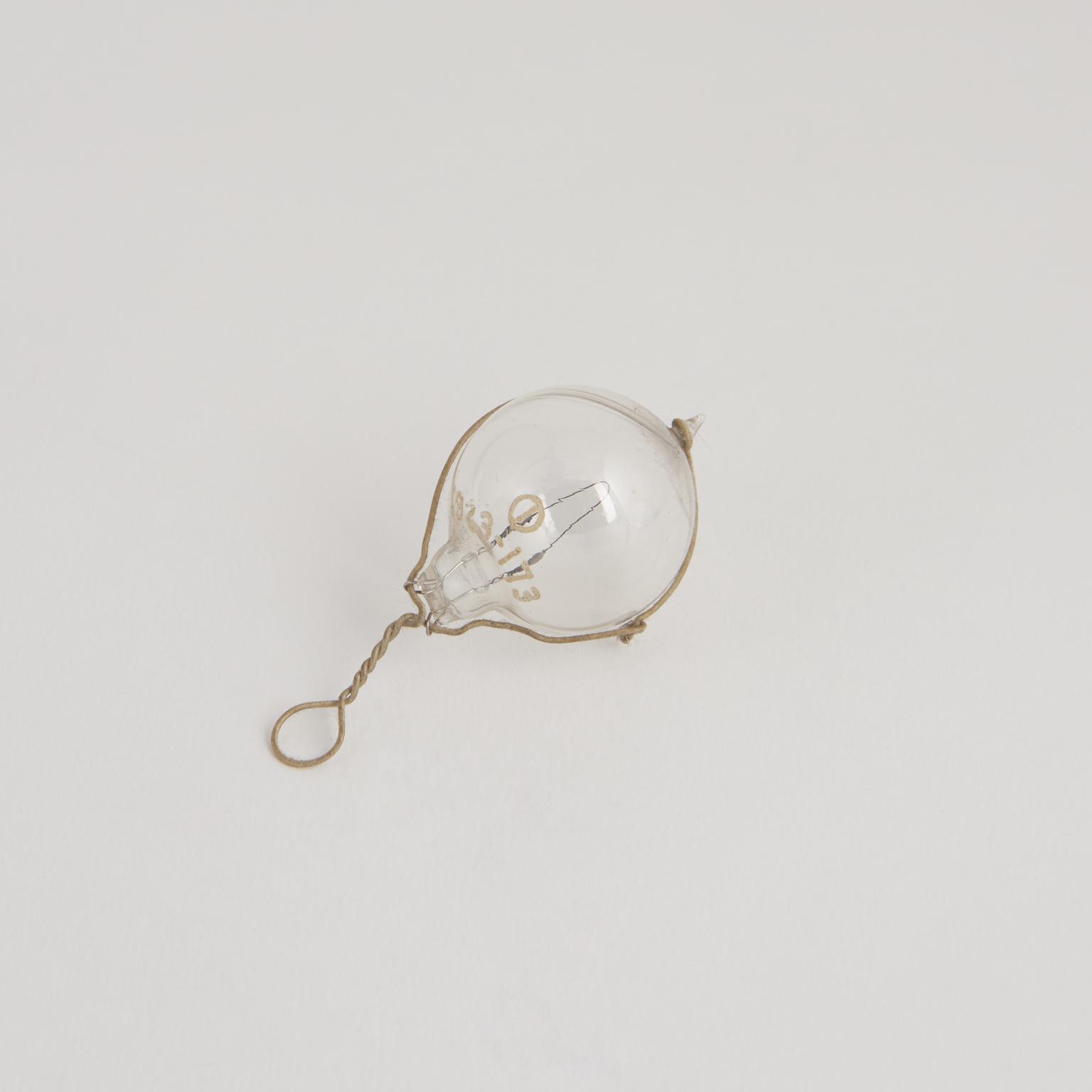
Incandescent lamp, carbon filament lamp
One of eighty-six early incandescent lamps: carbon filament lamp
- Object Number:
- 1923-173/1

Eighty-six early incandescent lamps: Carbon filament lamp.

One of eighty-six early incandescent lamps: carbon filament lamp
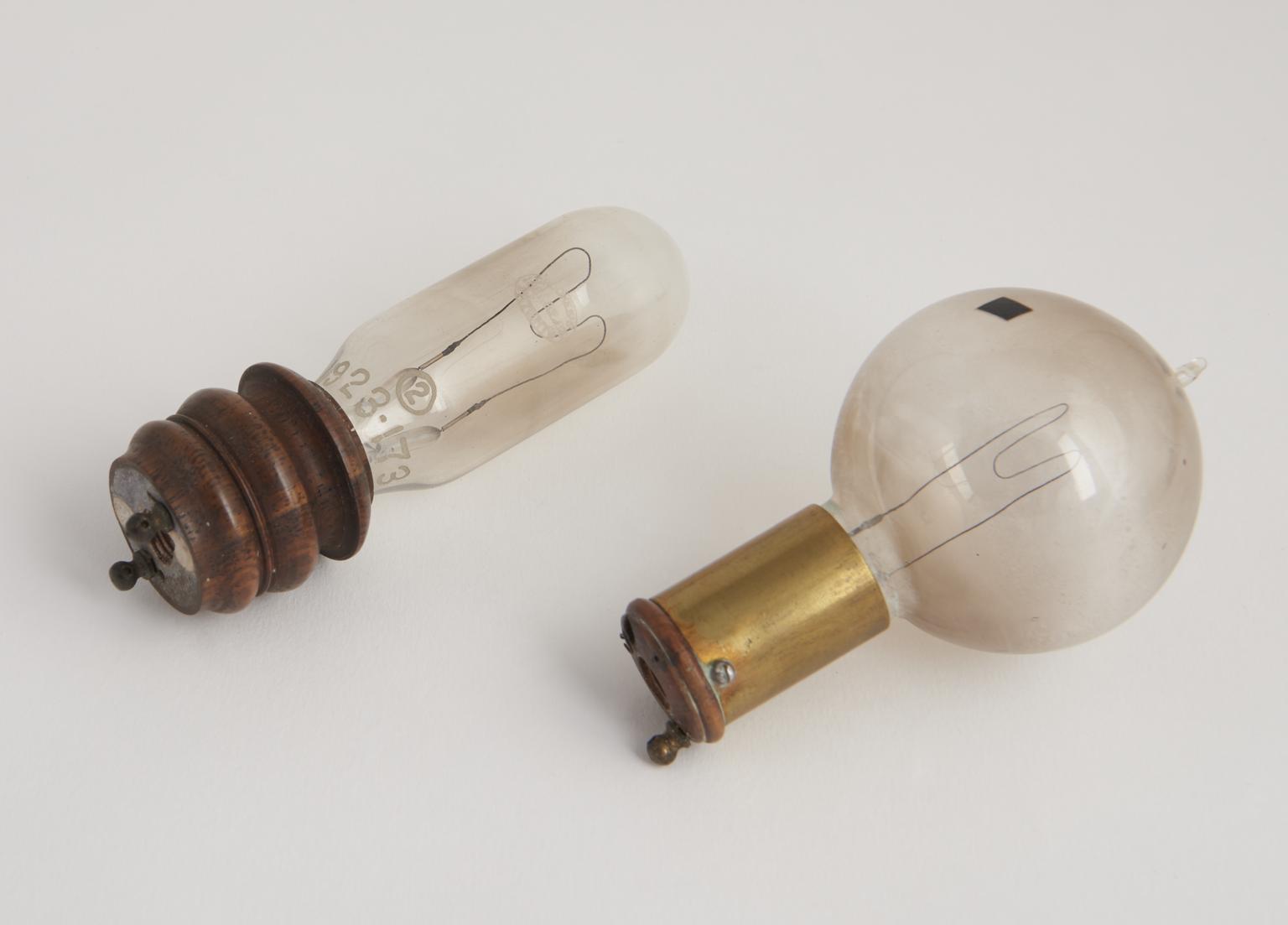
One of eighty-six early incandescent lamps

One of eighty-six early incandescent lamps

One of eighty-six early incandescent lamps
One of eighty-six early incandescent lamps
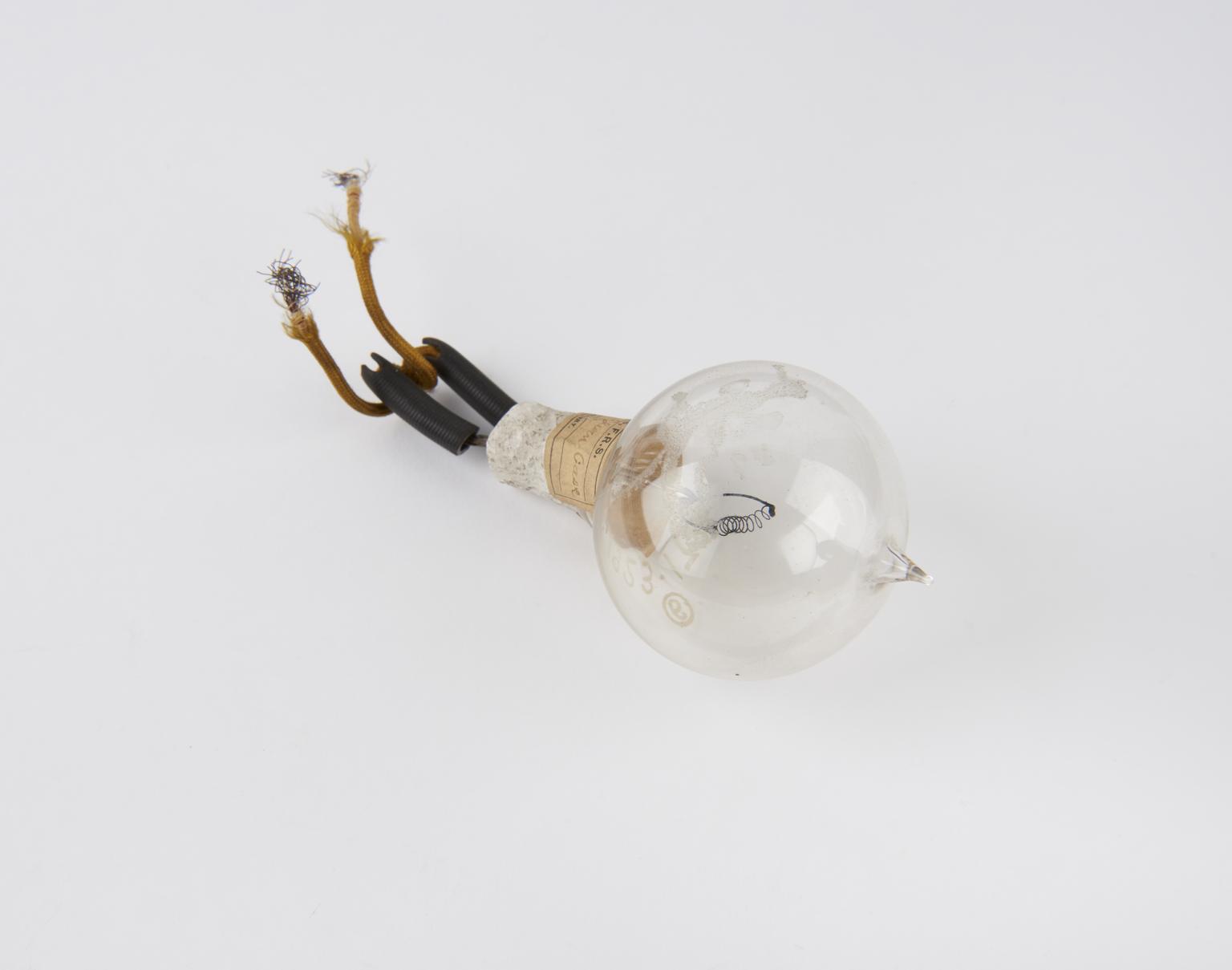
One of eighty-six early incandescent lamps: Replica of Ediswan lamp.
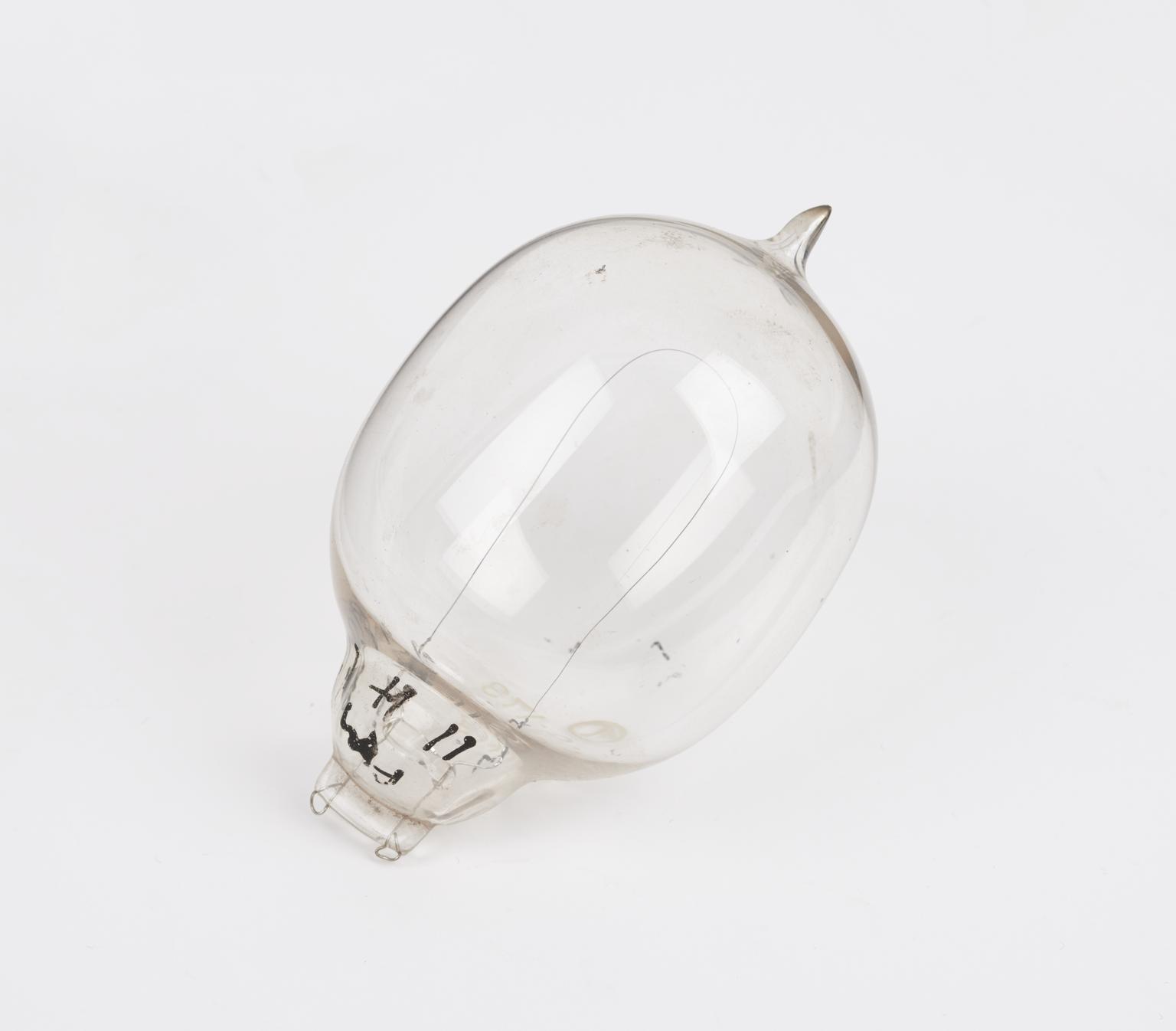
One of eighty-six early incandescent lamps
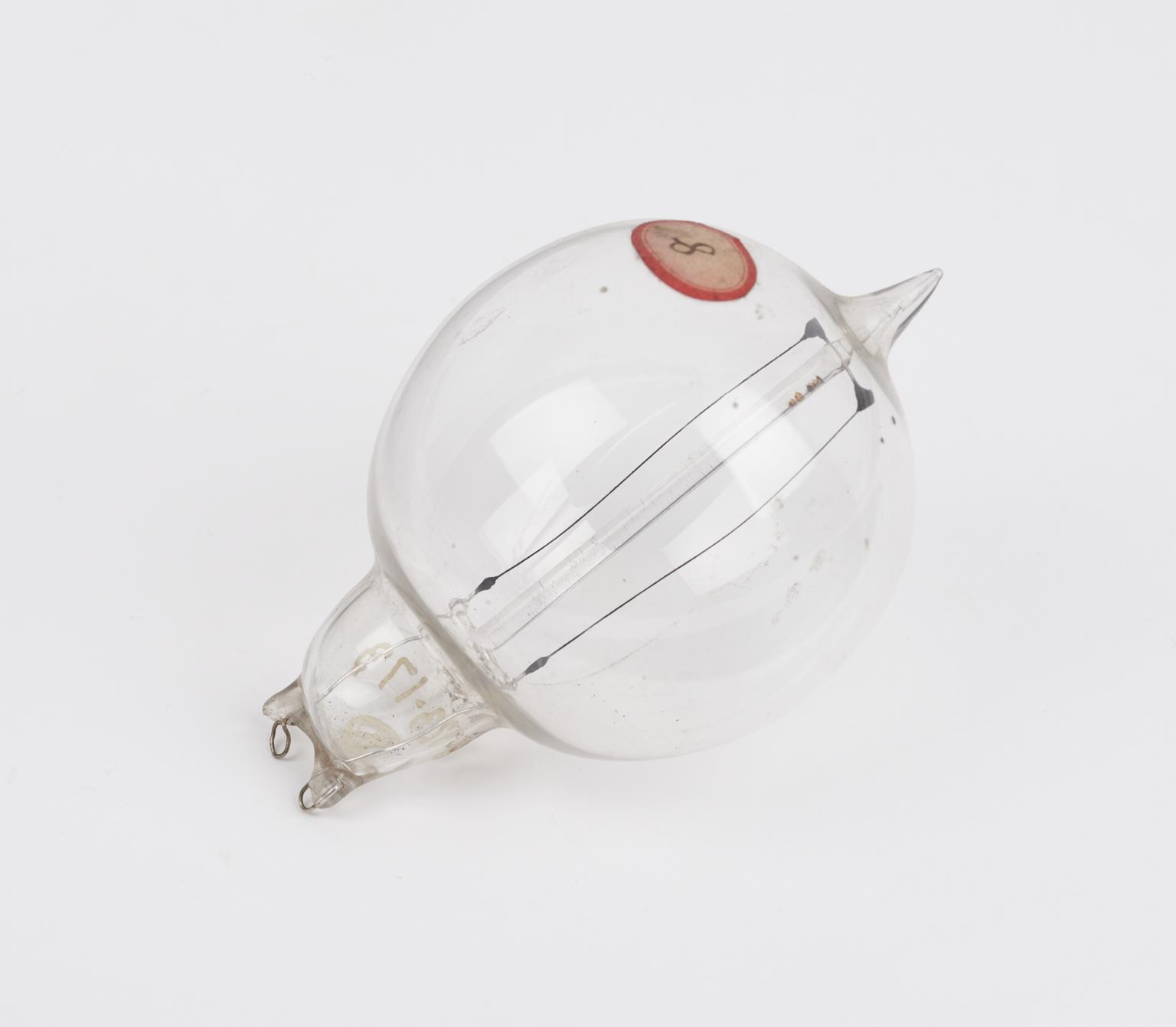
One of eighty-six early incandescent lamps
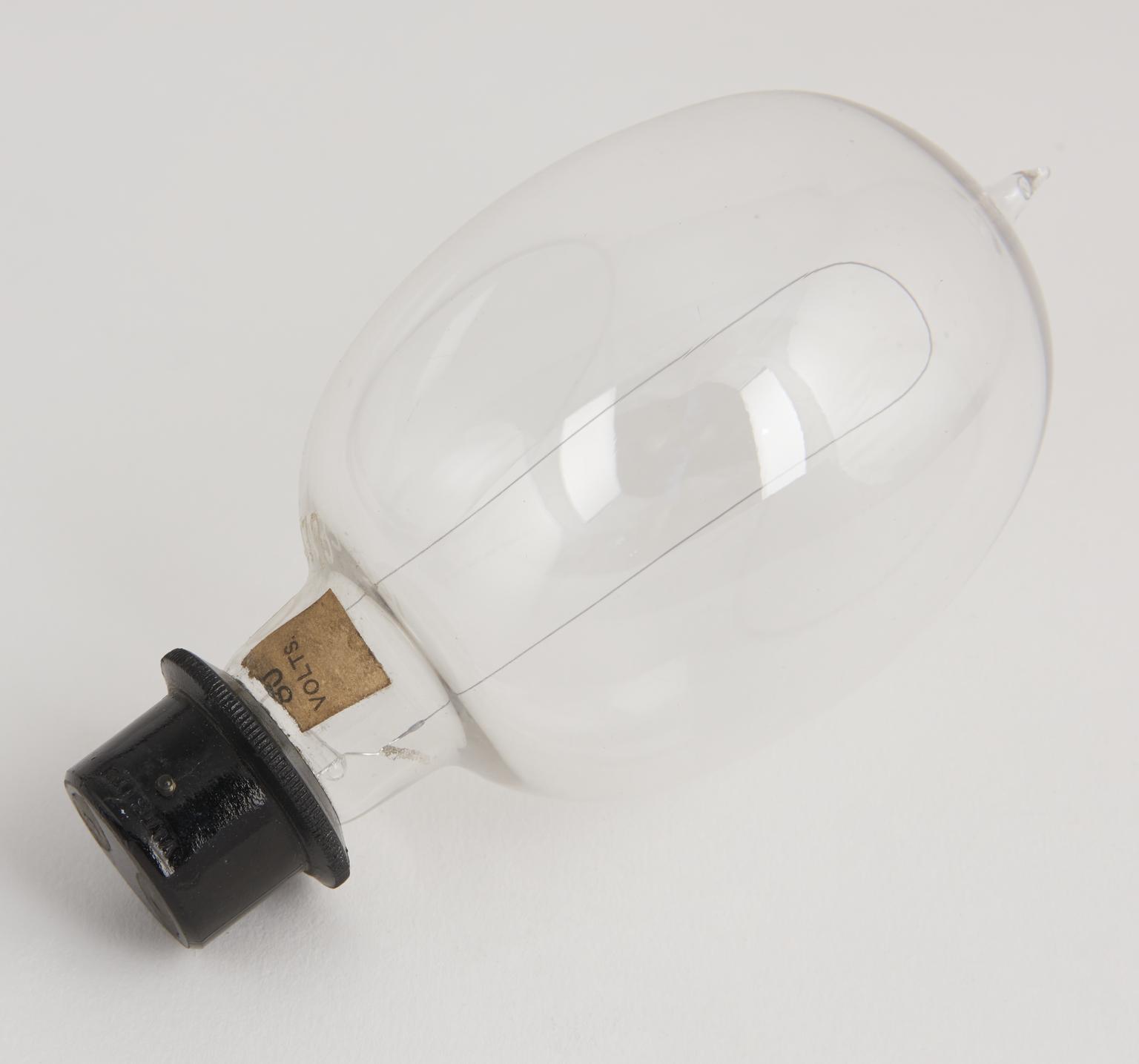
One of eighty-six early incandescent lamps

One of eighty-six early incandescent lamps
One of eighty-six early incandescent lamps
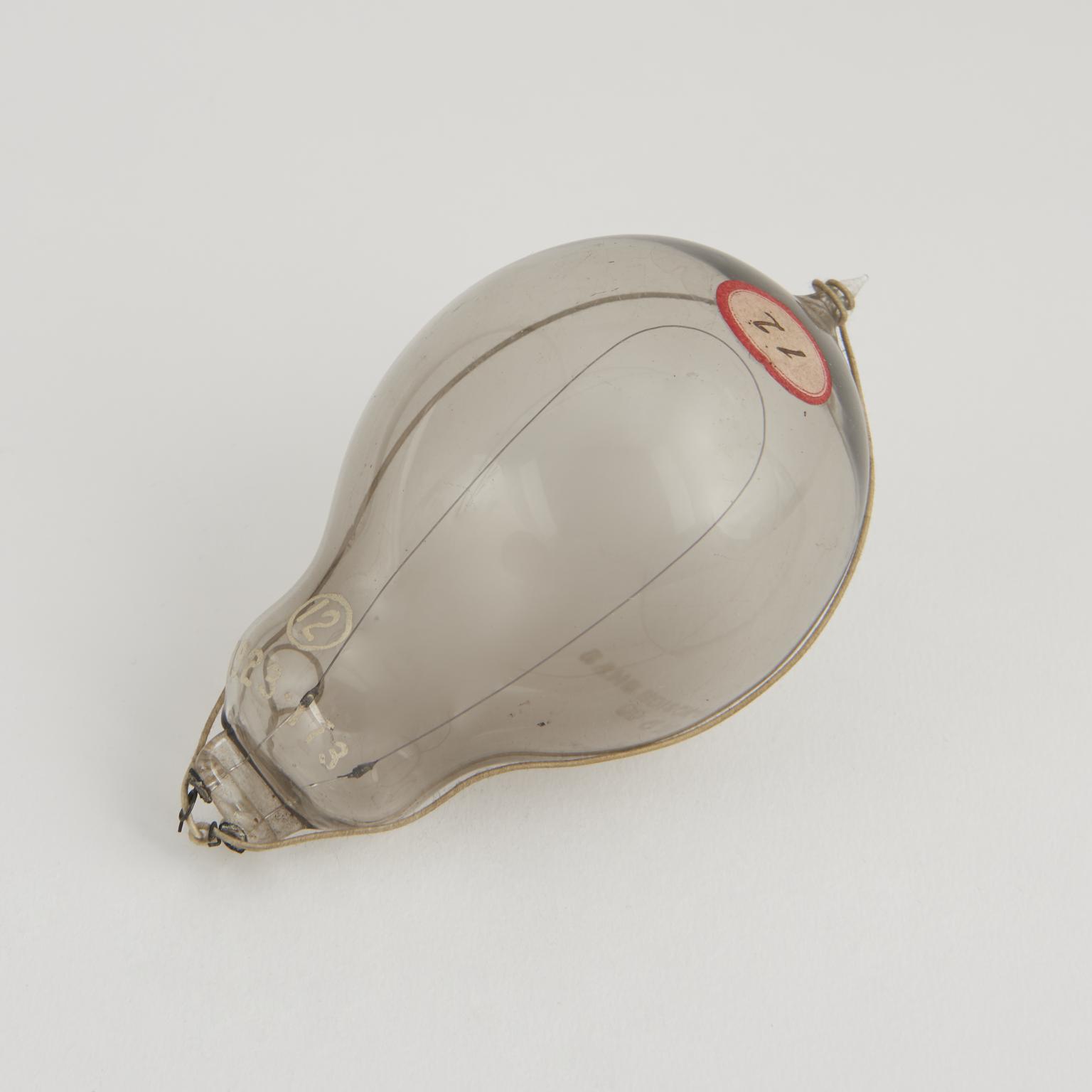
One of eighty-six early incandescent lamps: Edison Swan capless lamp
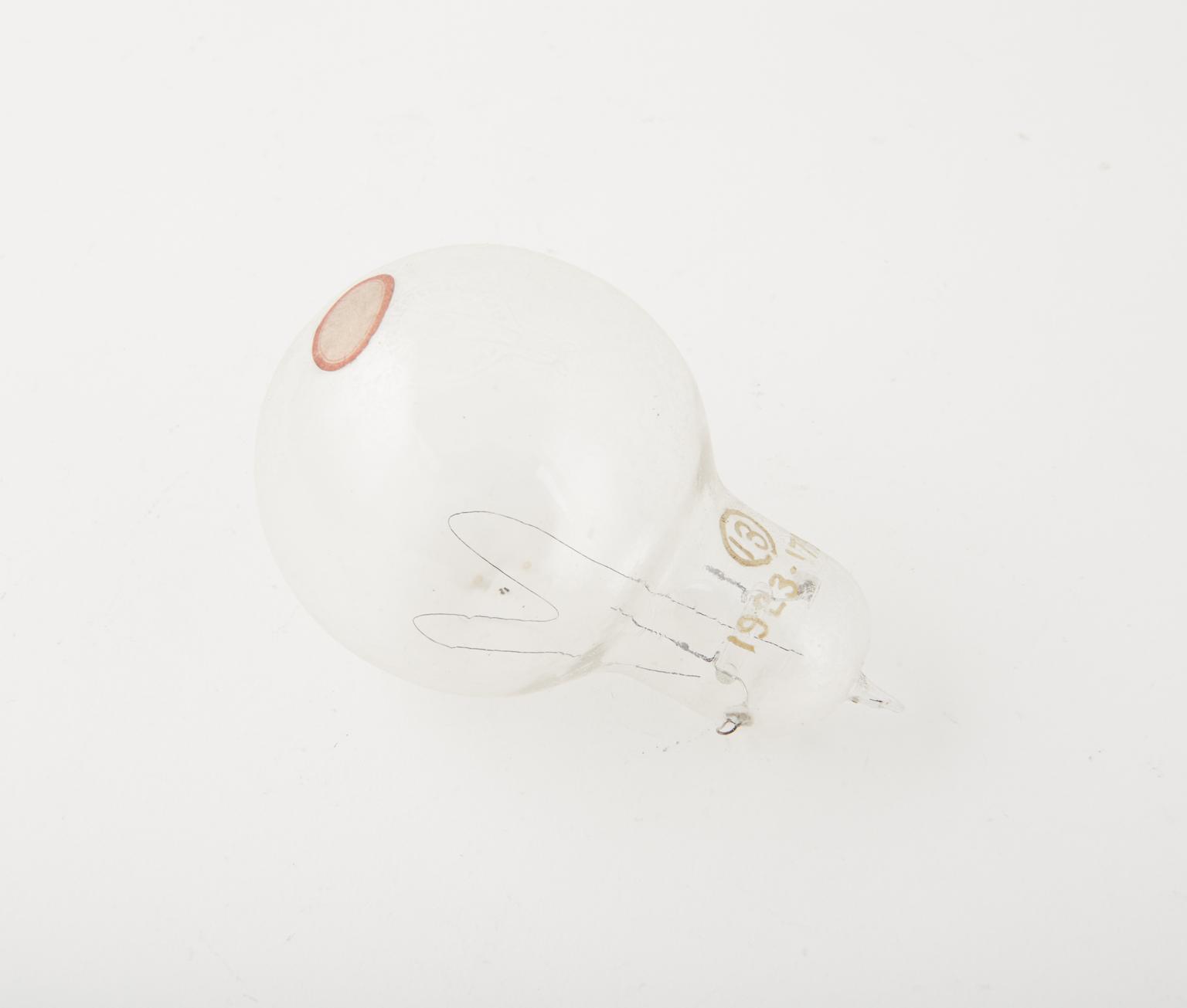
One of eighty-six early incandescent lamps

One of eighty-six early incandescent lamps

One of eighty-six early incandescent lamps

One of eighty-six early incandescent lamps

One of eighty-six early incandescent lamps: Carbon filament lamp

One of eighty-six early incandescent lamps

One of eighty-six early incandescent lamps: Woodhouse and ? lamp

One of eighty-six early incandescent lamps: Carbon filament lamp
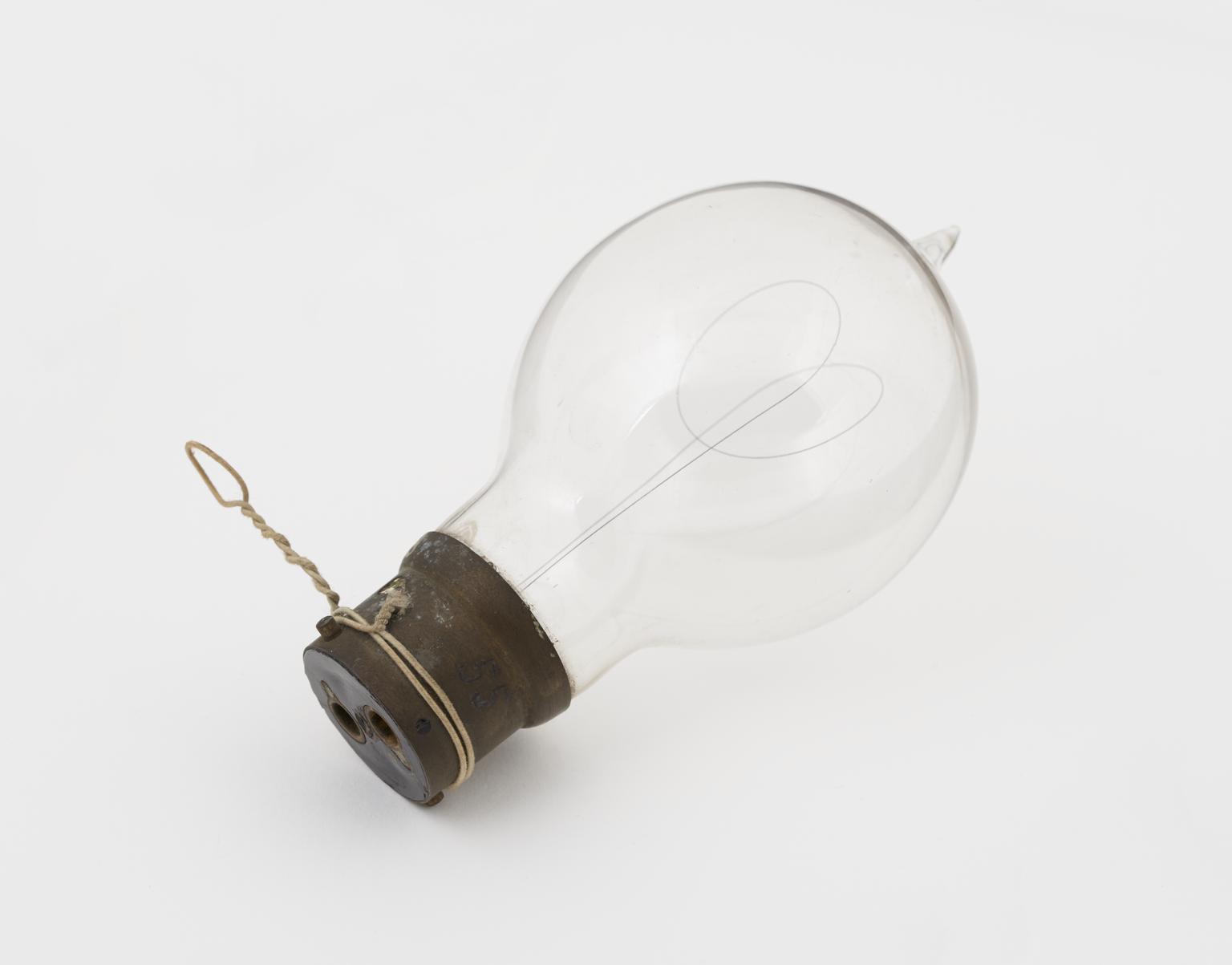
One of eighty-six early incandescent lamps

One of eighty-six early incandescent lamps

One of eighty-six early incandescent lamps: BTH and Co

One of eighty-six early incandescent lamps
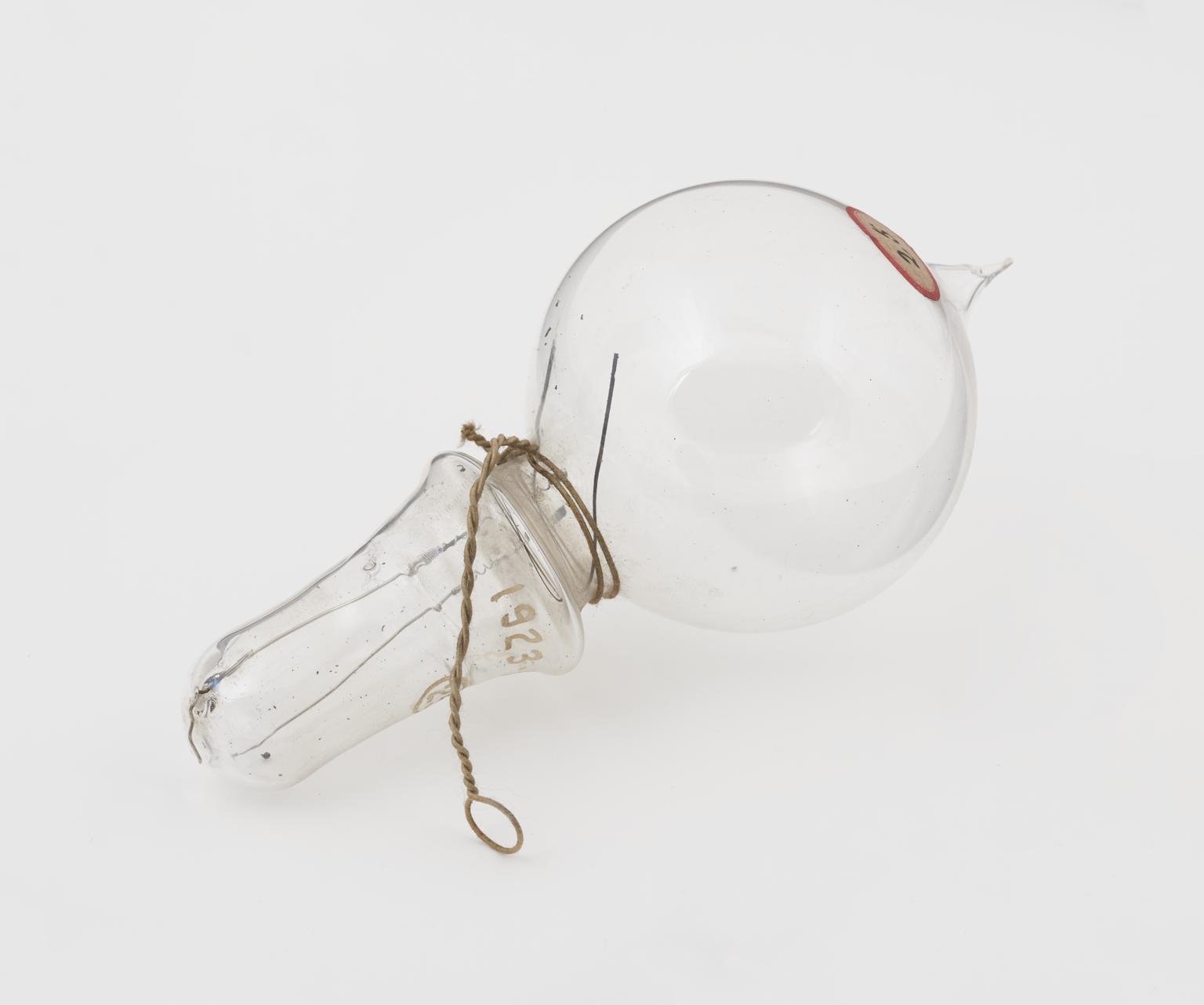
One of eighty-six early incandescent lamps

One of eighty-six early incandescent lamps: late Ediswan lamp
One of eighty-six early incandescent lamps
One of eighty-six early incandescent lamps
One of eighty-six early incandescent lamps
One of eighty-six early incandescent lamps
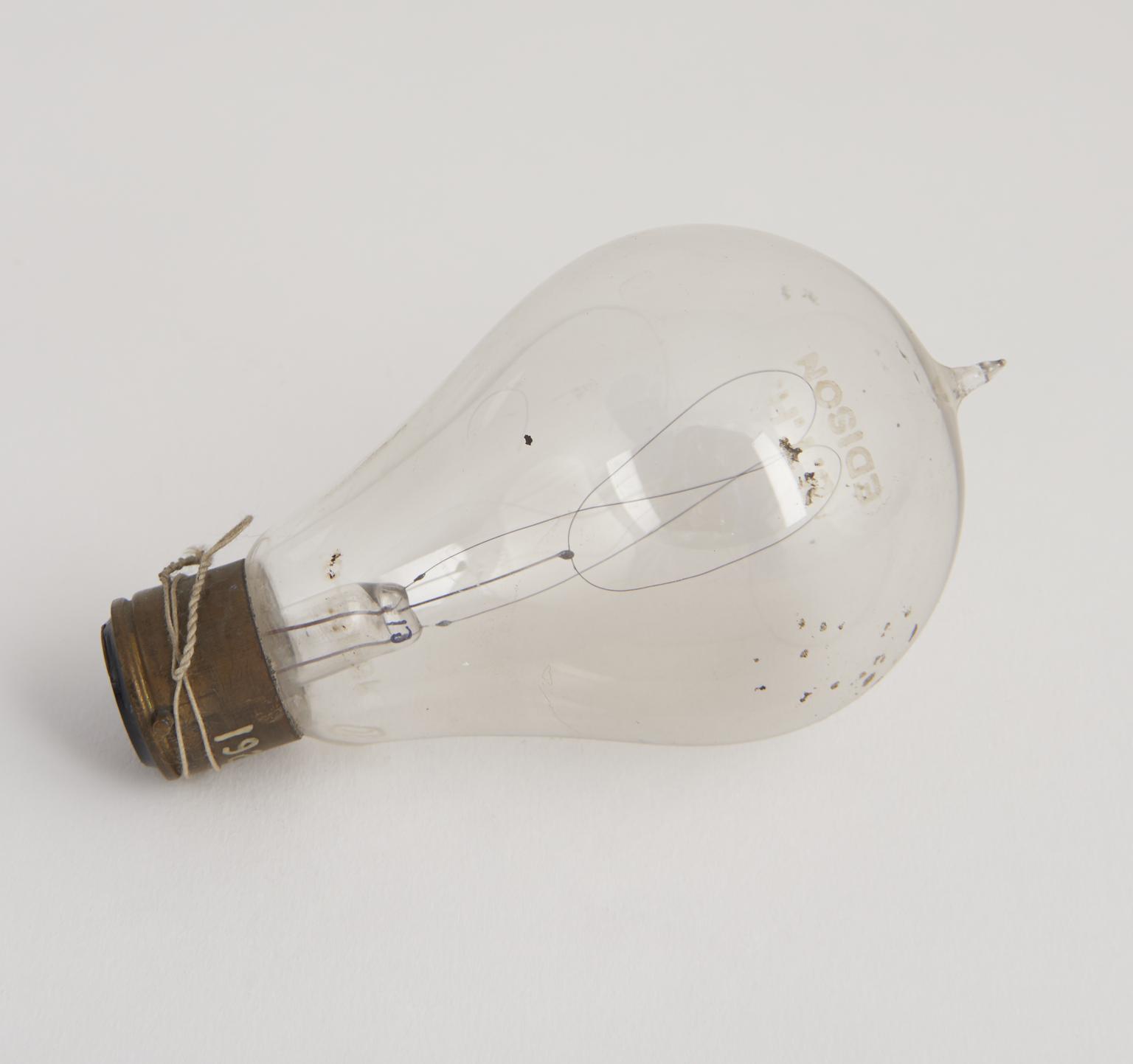
One of eighty-six early incandescent lamps: BTH/ Edison

One of eighty-six early incandescent lamps: Carbon filament lamp

One of eighty-six early incandescent lamps: Sunbeam lamp

One of eighty-six early incandescent lamps: Edison Swan lamp
One of eighty-six early incandescent lamps: Edison screw cap

One of eighty-six early incandescent lamps: G&A
One of eighty-six early incandescent lamps
One of eighty-six early incandescent lamps

One of eighty-six early incandescent lamps
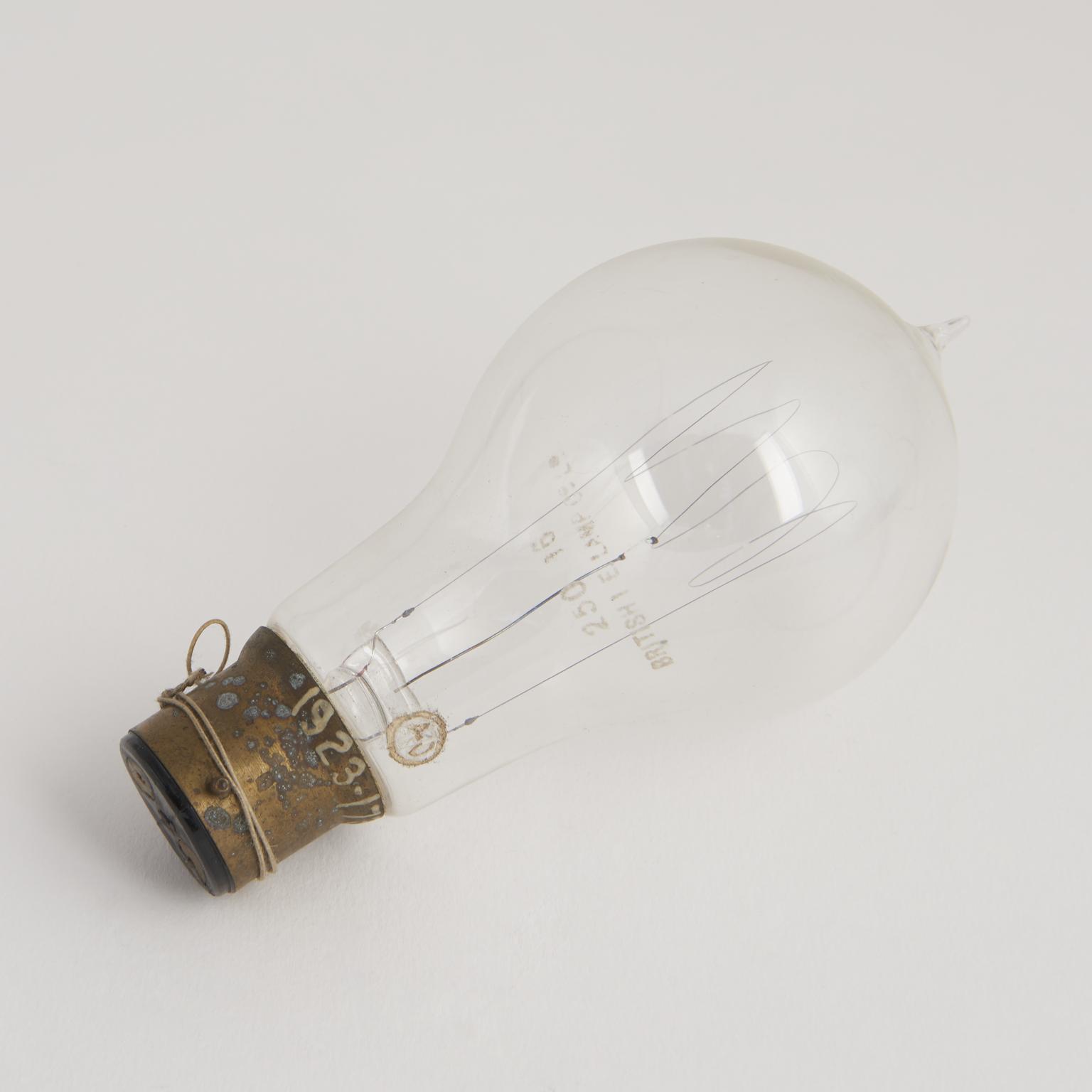
One of eighty-six early incandescent lamps: Carbon filament lamp
One of eighty-six early incandescent lamps
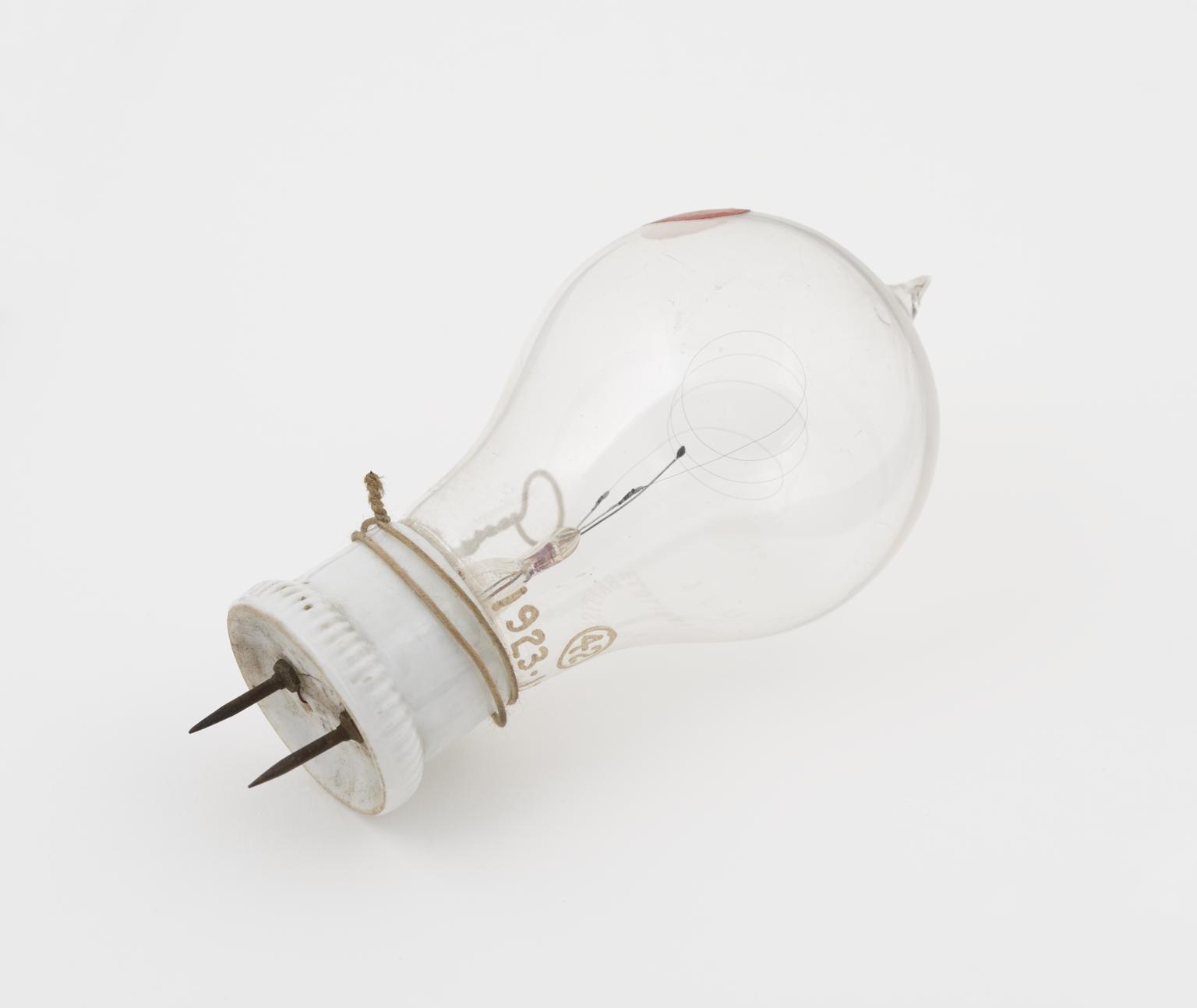
One of eighty-six early incandescent lamps

One of eighty-six early incandescent lamps: SVEA Stockholm

One of eighty-six early incandescent lamps. Carbon filament lamp, single loop filament, no filament supports. Attached to platinum leads pressing through seal. Pear shaped bulb, clear, slight shoulder at base. Top p.p. Base apparently of lead with wide male screw, incentre of which is second contact. Manufacturer unknown. No ratings - has remnants of stuck on paper label.

One of eighty-six early incandescent lamps. Carbon filament lamp, single filament make up of 2 straight carbon ? at top. Attached to lead in wiries drilled carbon cylinder. Lead in wiries sinlge piece bent platinum both passsing through one stem of red glass. Bulb clear, unusual shape, tapering, smallerratings at top than new base, with long panelled neck. Top pip. Cappal with writer leaved brass semicylinders surrounding neck, each solderd to one lead in wire. Gerard Lamp 1885 on stuck label (probably not original) also bearing number 1912192. No ratings given. Filament broken, bulb broken at neck but held together by cup.

One of eighty-six early incandescent lamps. Carbon filament lamp, 1 long arch filament with support at top with sealing pip. Cement joint to start lenght of platinum wire, item right-angle joint to copper wires attached to internal stem; item platinum wires thought glass, clear bulb - some blackening. Top pip. Non-standard brass cap attached with Plaster of Paris: pronounced flange, with central screw for attaching to holder. Shape suggests Edison lamp, but wrong base and not a bamboo filament. No markings

One of eighty-six early incandescent lamps. Carbon filament lamp, arch filament, one support into sealing pip, elongated clear bulb, with shoulder, well above base. Top pip. Carbon attached to short platinum (?) wires, than by right angle joint to bent copper wires supported by T shaped glass stem, than to platinum wires through glass. Cruto base, (brass cylindrial with flange, plaster attached & insulated, central screw for second contact). Cruto stuck on printed label says CRUTO 16 cand. 101 V

One of eighty-six early incandescent lamps. Carbon filament lamp, single looped filament, small attachement to short wires plucked in base, no internal stem. Ellipsoidal clear bulb. Top pip. Bayonet cap, pronounced shoulder, elliptical flat contact plates with wires soldered to the plaster of Paris attachment, but with black seal on base. Handwritten label says GABRIEL and ANGENAULT. 16 on stick on paper label.

One of eighty-six early incandescent lamps. Carbon filament lamp,arch filament, attachement not visible, bulb coloured red inside.Top pip. Non-standard cylindrical cap with flange, plaster insulated with central screw for attaching holder. Cruto (plucilled on paper label attached by string- other side carries name in ink Mr. B. Drake). 0,05 (on stuck on paper label) (c.p./volts ?)
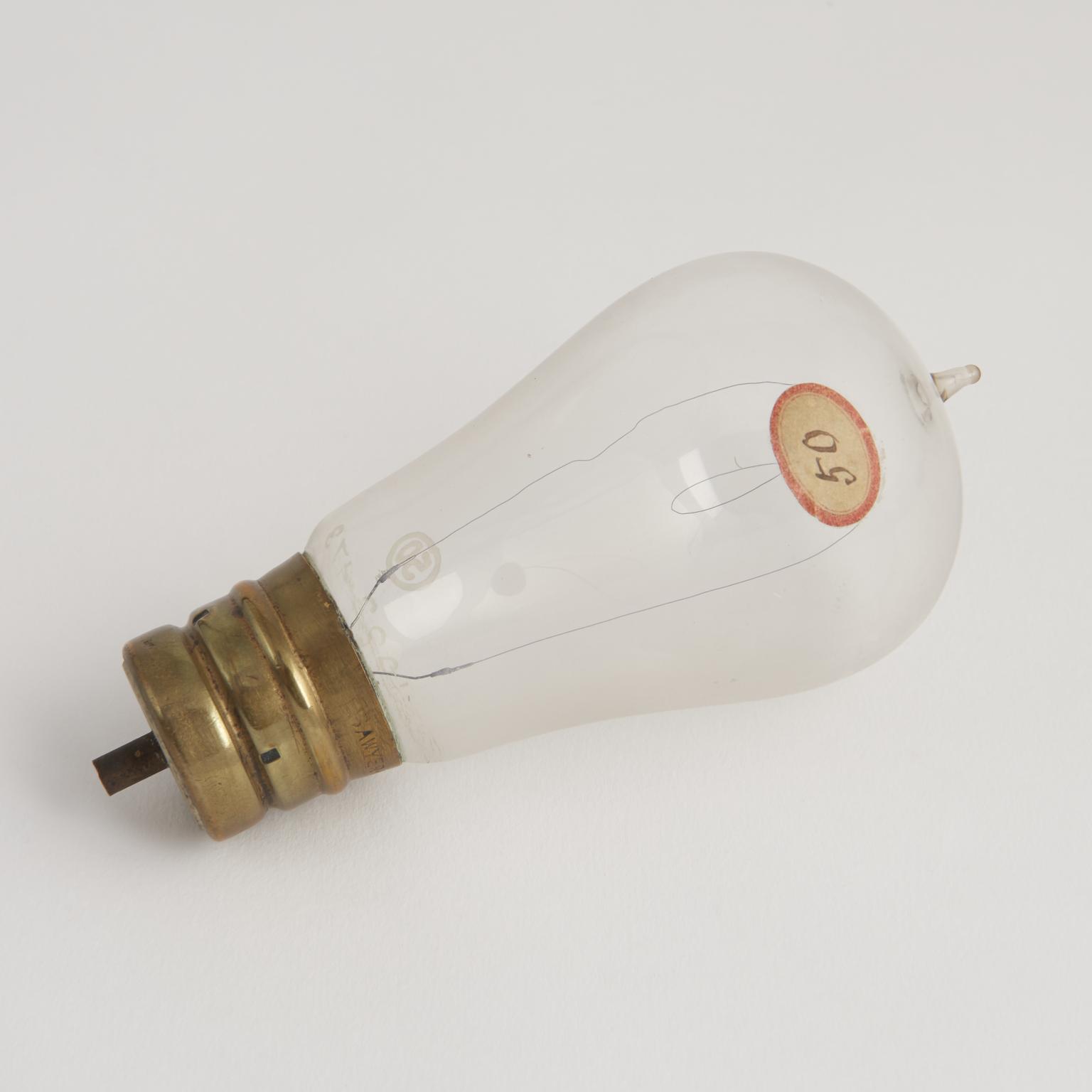
One of eighty-six early incandescent lamps. Carbon filament lamp, single-loop filament, no filament supports. Lead-in wires pass through short stem to copper wires other side. Clear tapered bulb, slight shoulder at base.Top pip. Westing house base. (Brass cylinder with circular ridge and groove,plaster attached and insulated, projecting pin for second contact). Maker unspecified but base carries words engraved "Sawye-Man patents"; Westing house concentrated its lamp production through its Sawyer Man subsidiary inthe years around the turn of the century, and it had done this in 1892 to avoid patent problems. No ratings given.

One of eighty-six early incandescent lamps. Carbon filament lamp, single looped filament, with two supports attached to top of bulb ( I now disengaged). tapered clear bulb.Top pip. Cylindrical brass cap with circular groove, plaster insulated with recessed large diameter pin for second conduction. Manufacturer unknown. "16"8"110" printed on base (c.p. volts?)
One of eighty-six early incandescent lamps. Carbon filament lamp, single looped filament, small minor glass stem, with 3 part "Siemens seal" (carbon attached directly to upper copper wire). Pear shaped clear bulb. Top pip, broken. Cylindrical brass cap attached by Plaster of Paris with projecting central split pin for second contact. "Siemens" handwritten on cap. Stuck-on paper labelsays 100/16 (volts/c.p. ?)

One of eighty-six early incandescent lamps.Carbon filament lamp, single loop filament, no filament support. Filament attachment not visible. Pear shaped bulb with shoulder where it joins base, white opal material. Top pip. Cylindrical brass base, plaster insulated and attached with two projecting split pins for contacts. Manufacturer unknown. No markings.

One of eighty-six early incandescent lamps. Carbon filament lamp, single loop filament (broken), no supports. Lead in wres held by glass bead then through seel clear pear-shaped bulb, with shoulder adjacent to base. Top pip. Siemens & Halske base (brass cylinder attached by plaster with connection to two "wings" sticking out fromplaster done at bottom). Siemens & Halske handwritten on base. No ratings given.
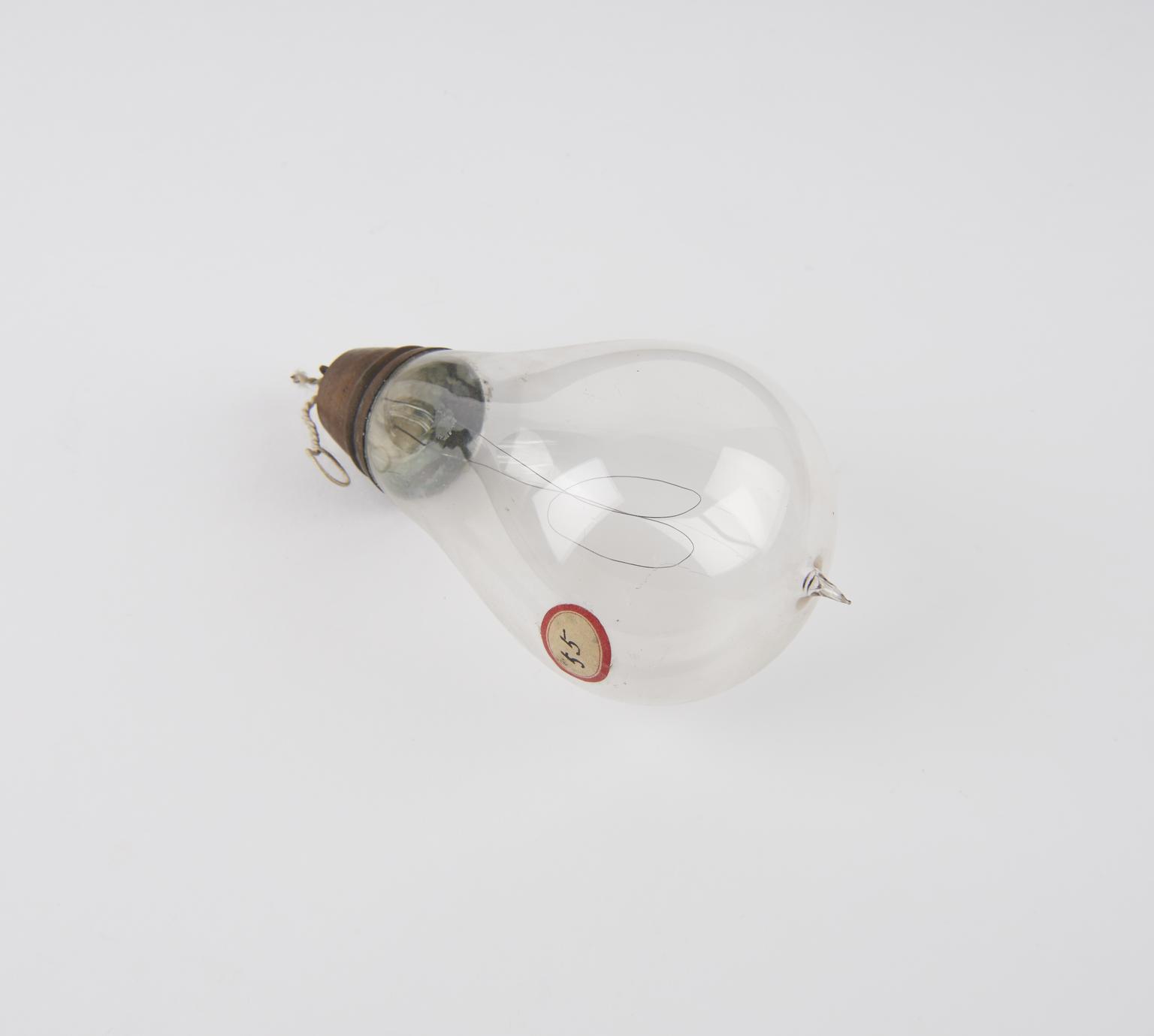
One of eighty-six early incandescent lamps. Carbon filament lamp, single elongated-loop filament, attached to lead inwires passing through quick seal. No filamnet supports. Tapered bulb, clear.Toppip. Tapered brass base continues line of bulb,plaster filled, two tags stick out from base for connection. Manufacturer not specified. No markings.
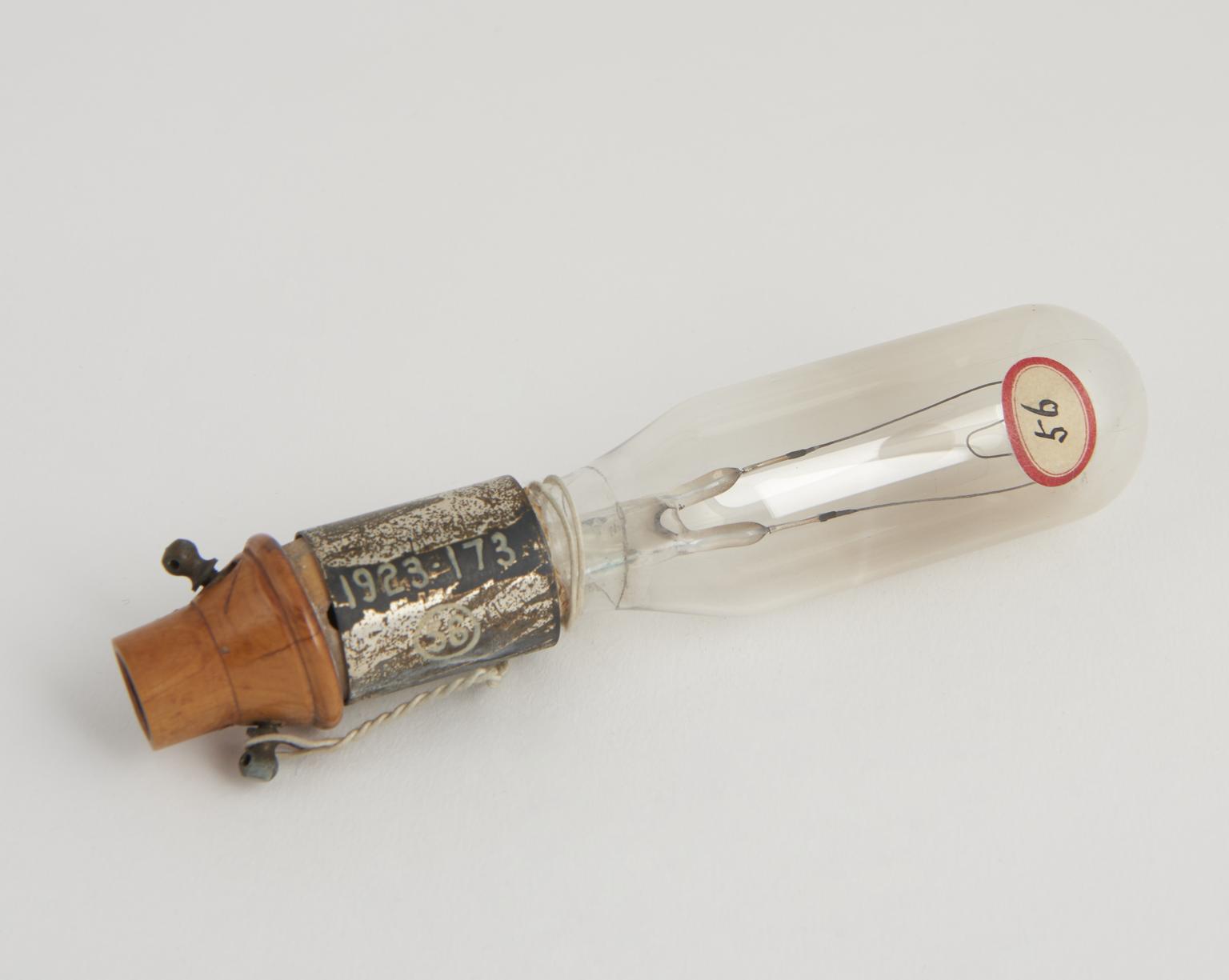
One of eighty-six early incandescent lamps. Carbon filament lamp, M-shaped cylindrical thikish filament. Filament attached by paste to plpatinum tubes crumped over lead in wires in split internal stem, apparently attached to copper wires at other side of glass. Clear cylindrical bulb. No visible pip. Attached to cylindrical metal base by plaster, with wooden plug (now loose) carrying two contact posts and with female screw thread. No markings. Some similar feature to 1923-173/85.
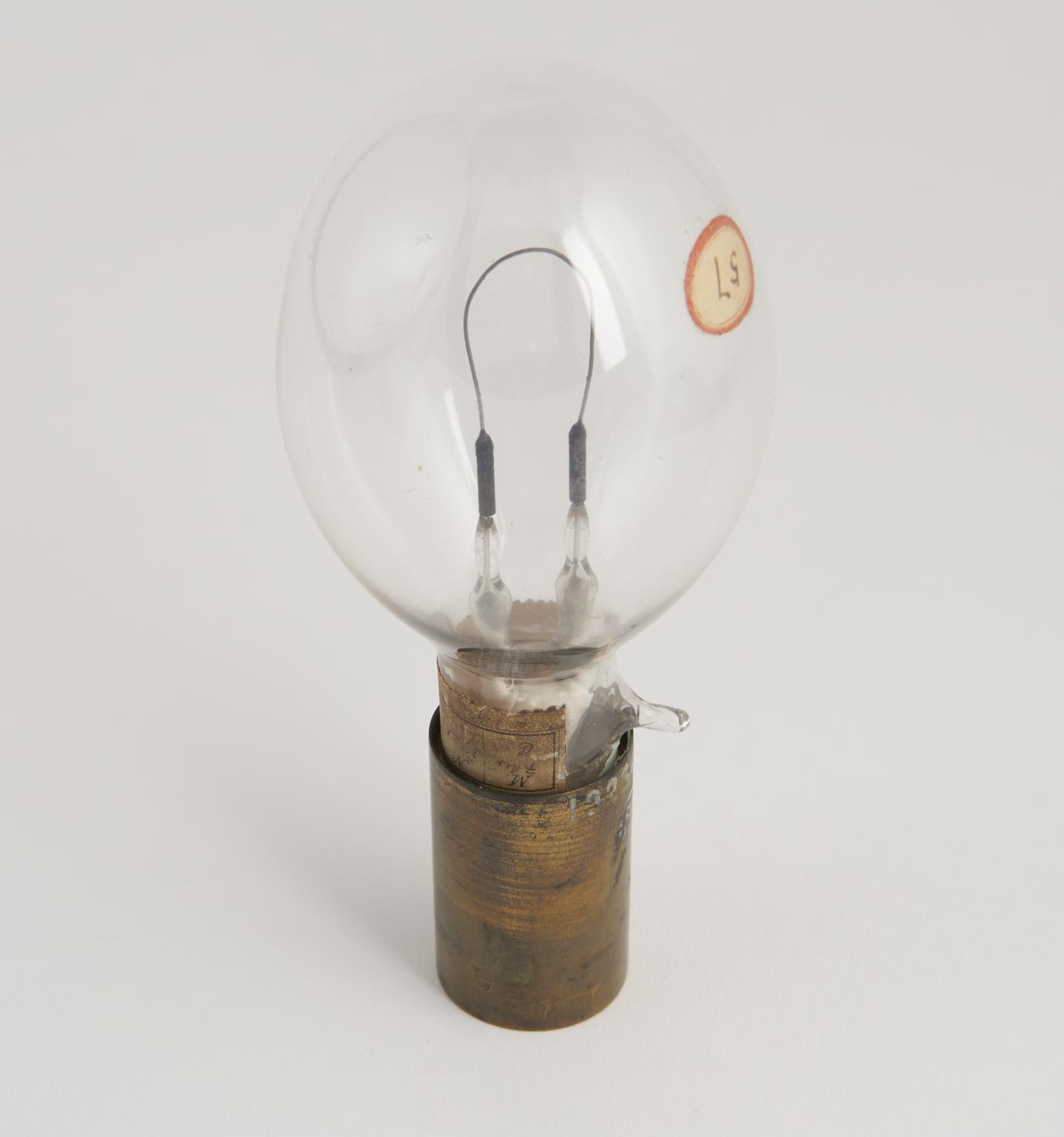
One of eighty-six early incandescent lamps. Carbon filament lamp, 1 arch filament stick. Cemented into longitudically drilled carbon cylinders filled over lead-in wires which pass through twin stems containing mercury and sealed with plaster.Clear bulb. Pip at side of neck. Loosely attached brass cap with fibre (?) insulation between outside and central contact to which wires are connected. Lane-Fox 1882?. Paper label stuck to neck says: M. 7UC, N. 3721, R. C34HI, EMF. 54 (?), S. 16,7, N.C.P. 20.

One of eighty-six early incandescent lamps. Carbon filament lamp, single loop filament, no filament supports. Filament cemented into drilled carbon cylinders filted over platinum lead inwires passing into two glass stems containing mercury and filled with plaster. Bulb ellipsoidal, opal glass, joined to clear glass just above long neck; lamp has snapped at neck, but been glued back into position; no vacuum. Sealing pip at side of neck. Base: copper wires lead out of plaster ( 1 now broken) through fibre washer at bottom of loose fitting brass cylinder one wire originally soldered to cylinder, one central metal pin. Lane-Fox. No ratings specified.
One of eighty-six early incandescent lamps
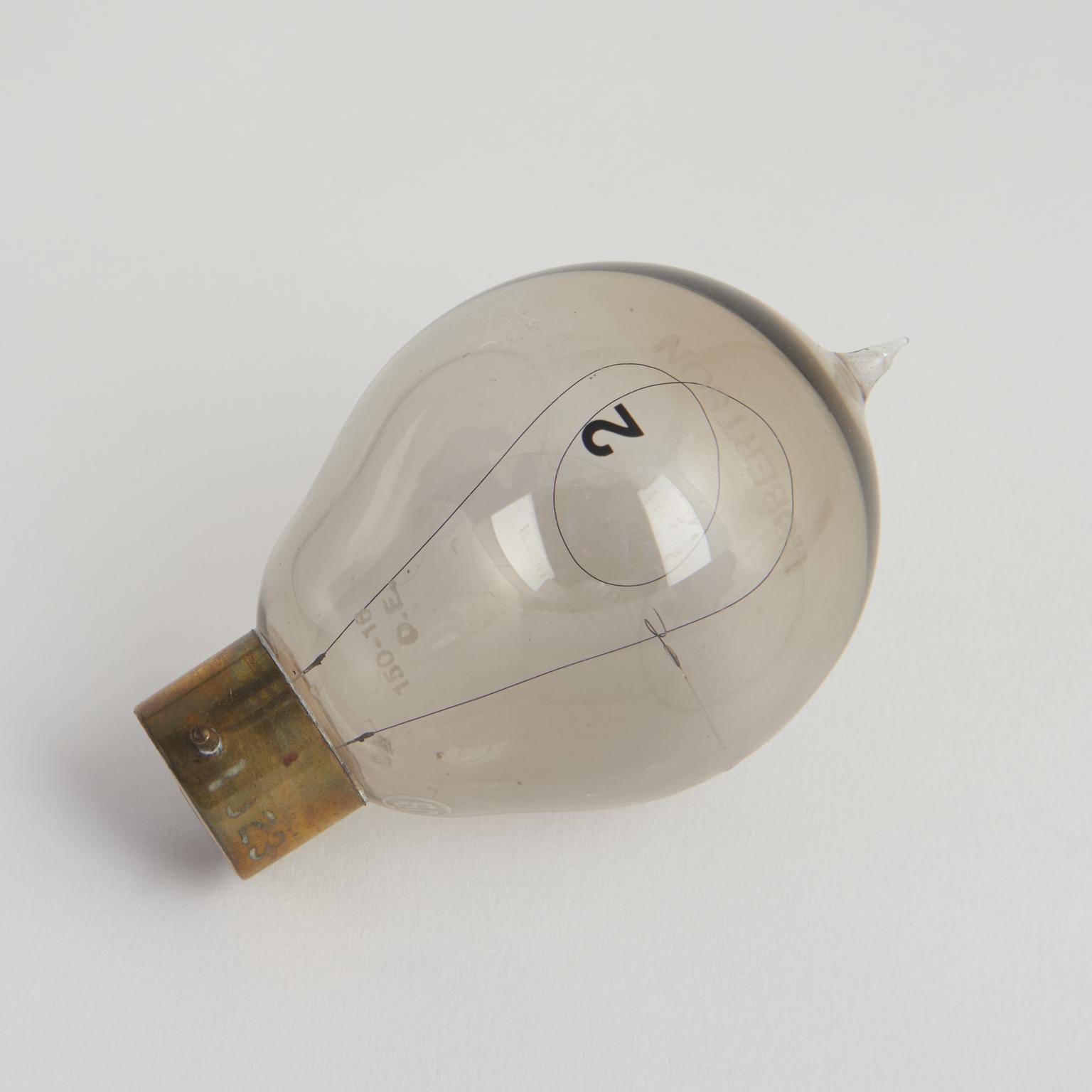
One of eighty-six early incandescent lamps. Carboon filament lamp, single loop filament, one support attached to side of bulb. Attachement method? Clear bulb. Top pip. Bayonet cap with large flat brass contact plates plaster insulation. Robertson ( etched on glass).150-16 D.E. (etched onglass) (volts & c.p.?).
The Robertson Company began to manufacture lamps in 1895. J. C. Robertson had begun working on electric lamps with St. George Lane Fox and the factory used by the company had originally belonged to the Brush Company, which had once manufactured Lane Fox lamps. Like other companies, the Robertson Company made a wide range of lamps.
This lamp is an early form of bayonet cap, 150V, 8 c.p.
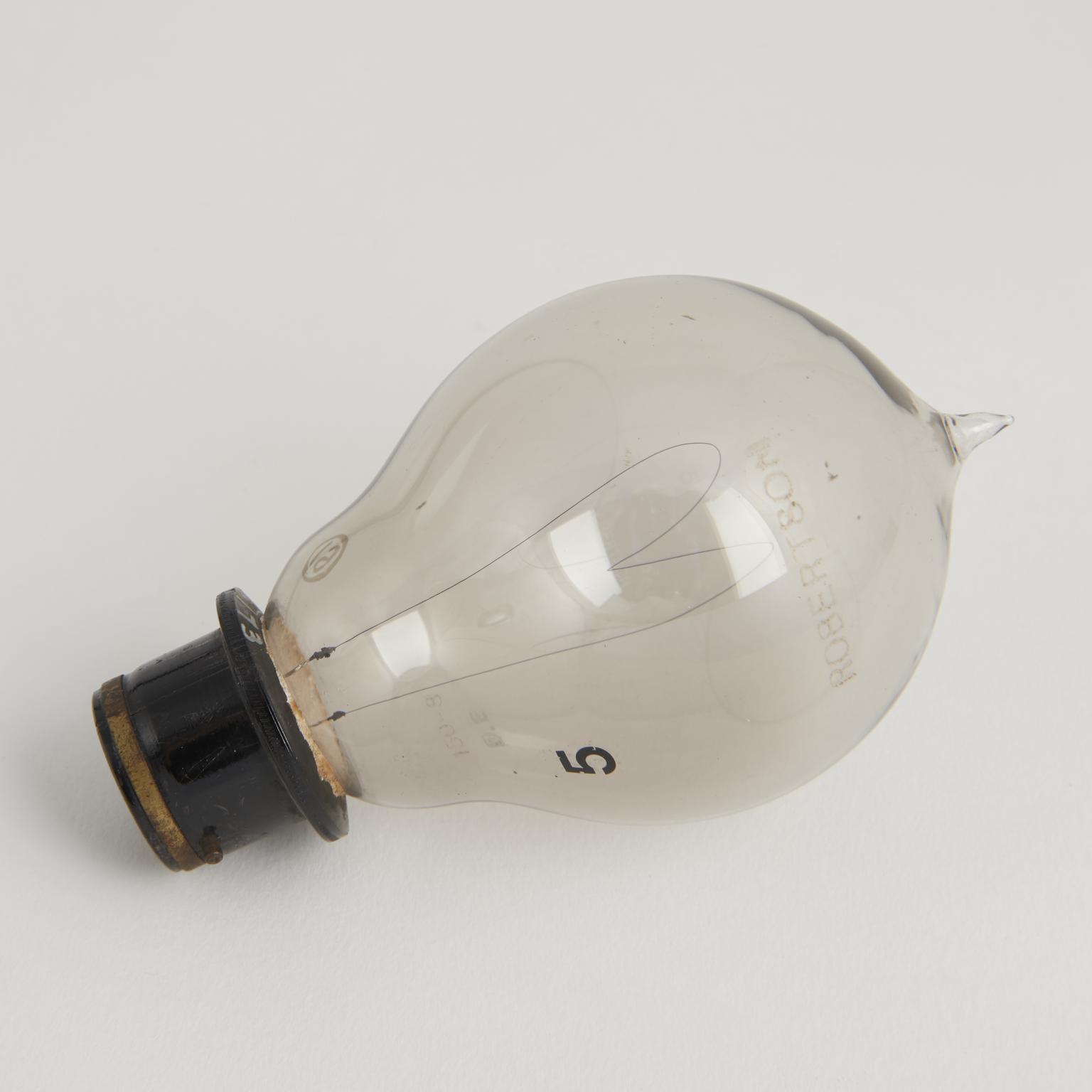
One of eighty-six early incandescent lamps. Carbon filament lamp, single loop filament, attached by deposited carbon joint to short lead in wires in pinched base. Clearbulb, top pip. Bayonet cap with brass contact plates to which leads through glass are soldered. Pronounced flange & brass ring round cap. Cap is black. Attached by plaster. Robertson (etched on glass), 150-8. D.E. (etched on glass) (volts & c.p. ?).
One of eighty-six early incandescent lamps. Arch Filament, No supports, Lead-in wires pass through long stem, tear dropped shaped bulb, claw, top pip. Non-Standard brass base slightly tapered with shallow groove and pronounced flange, plaster attached and insulated, with flush central button for second contact. No markings.
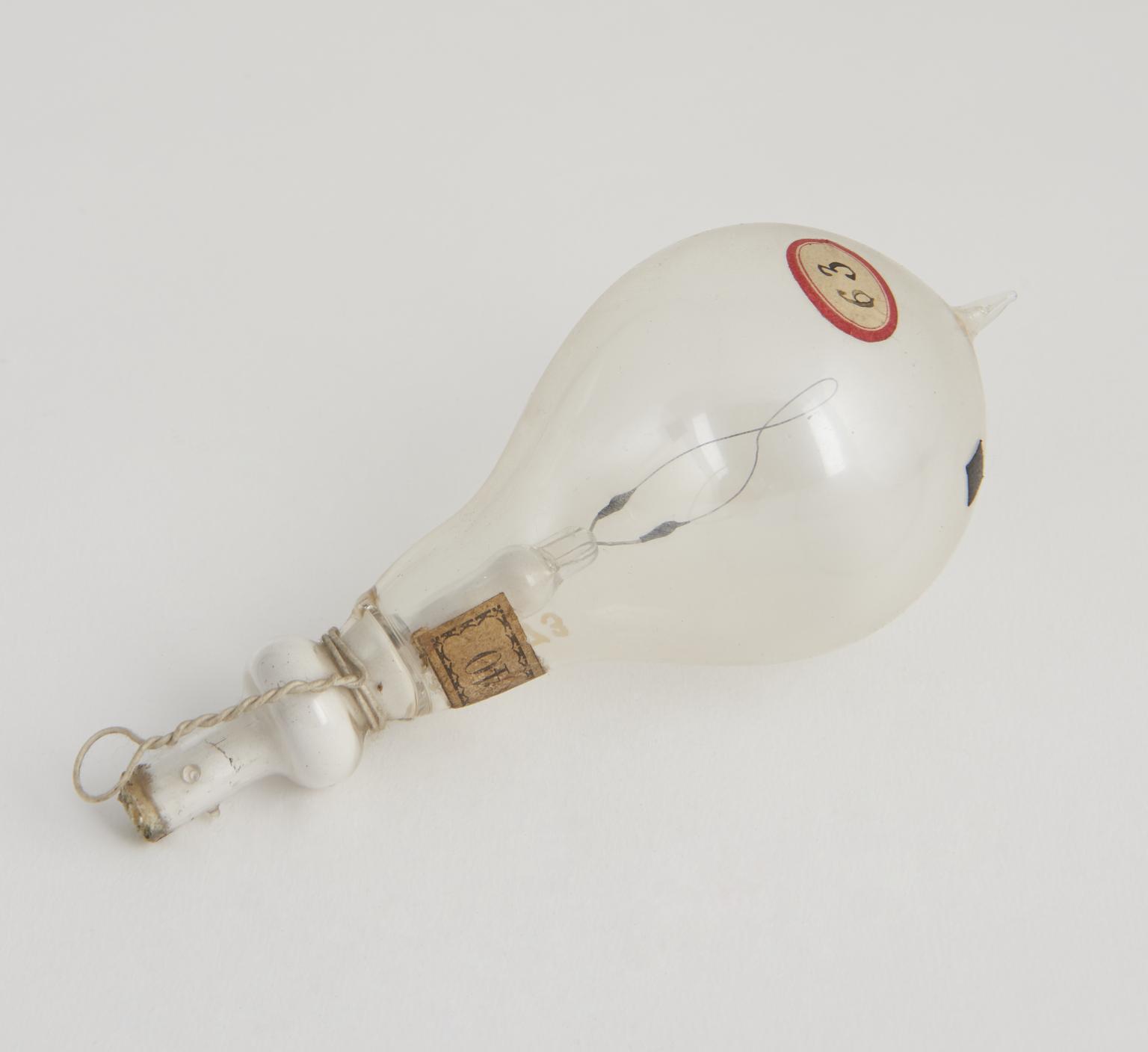
One of eighty-six early incandescent lamps. "Twisted arch" filament. Bulky cement joint to lead in, wires in pinched internal stem filled with plaster of paris. Clear bulb, top pip, no cap, wires broken at surface of plaster of paris pronounced "belly" in stem. 40 on stuck-on paper label. Candlepower?

One of eighty-six early incandescent lamps. Straight horizontal short thick carbon filament. No support. Carbon attached by pieces of (?) platinium bend round near the ends, platiniums sandwich the end of the copper supports to which it is electroplated. Copper supports of the shape which could short circuit when carbon breaks, but there is no indication that they are sprung. Copper attached to platinium wires passing through glass. Flattened spherical bulb with neck and pronounced flange at joint with base. Clear bulb, top pip. Cylindrical brass base fibre (?) insulated , with twin projecting connecting posts.
One of eighty-six early incandescent lamps. Single loop filament, no loop supports. Cemented joints to leads passing through single glass stem. Round clear bulb with short nexk. Top pip. Cyclindrical Brass base, oversize for neck of lamp, attached by plaster, with projecting brass pin and spring off centre. Lamp is brass turning, with female thread at bottom containing loose wooden insert with brass contact plate, held and positioned by single lug fitting dimple on lamp base, (similar to those used on bayonet cap). Swan United Electric Light Co. Ltd. etched on bulb. No ratings marked (probably 20 c.p. - that was standard). Date must be 1882 or 1883.
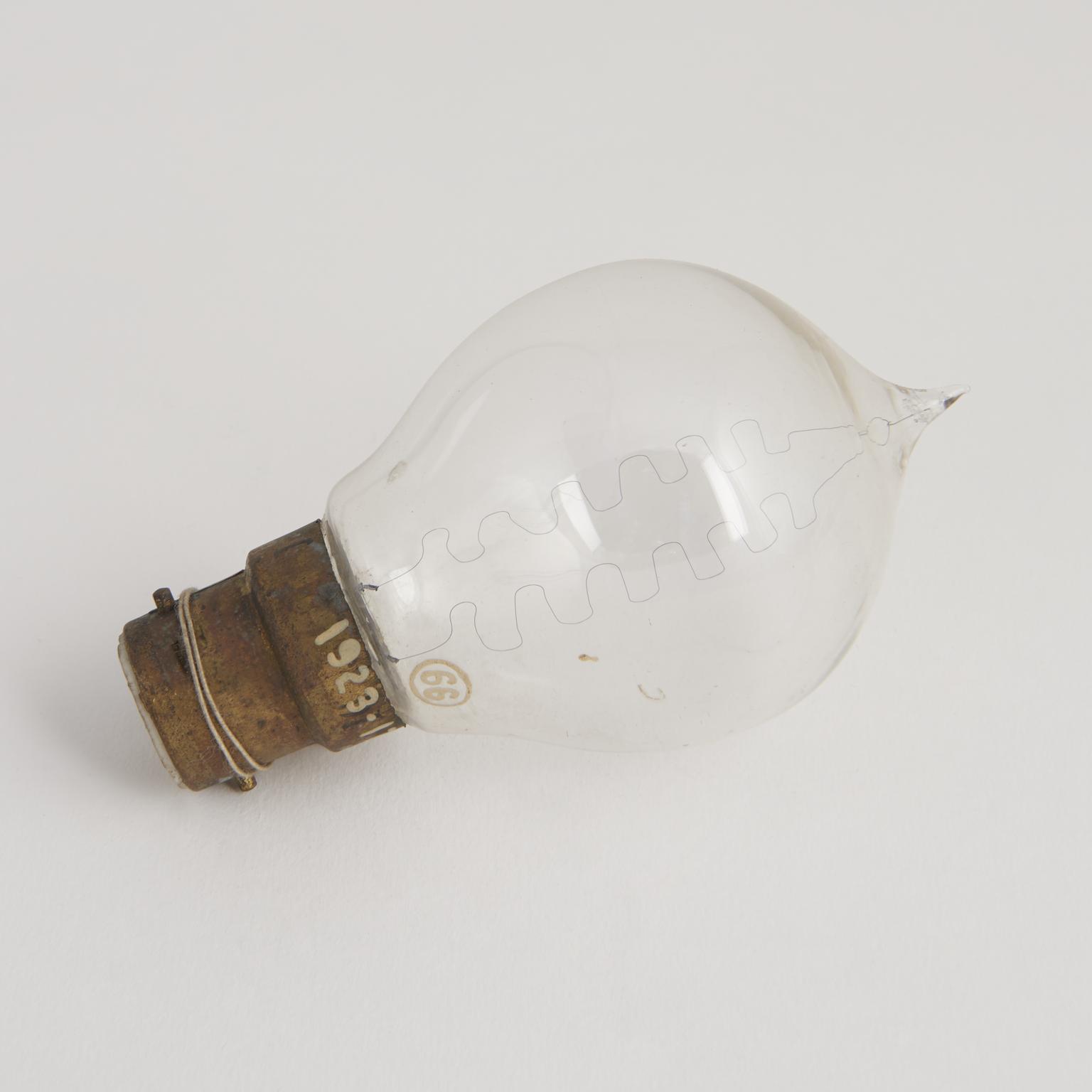
One of eighty-six early incandescent lamps. Zig-zag filament. One filament support into sealing pip. Platinium leads pass through seperate seals in bulb. Pear-shaped bulb, with shoulder at base. Top pip. Bayonet cap base, with shoulder and flate elliptical brass contact plates. porcelain insulated otherwise hollow. Manufacturer unknown, but handwritten label stuck to base says "German make." 200 - 16 on base (volts - c.p.). Filament shape similar to Bristol Electric height Co. Lamp1923-173/7D.

One of eighty-six early incandescent lamps. Single loop filament. No filament supports. Lead-in wires not visible. Pear-shaped bulb, clear, top pip. Base similar to Westinghouse type, but some differences- brass cylinder comes long way of bulb neck, has groove but no raised ring and porcelain insulation. Extends part way down centre pin. Ediswan etched on glass. 100 - 16 - A64 etched on glass.

One of eighty-six early incandescent lamps. Arch filament, thick and stiff. No support. Filament affects to have thickened ends resting on right-angle-bent platnium (?) Wires - the end of the filament proper passing through holes in the wires. Platiniums connected to substantial copper wires (showing what appears to be oxidation) held apart by mica (?) plate to which they are rivetted. Each copper wire is welded to four platinium wires passing through a pinch seal. Large clear pear shaped bulb. Top pip. Large Thomas Houston base, plaste attached and insulated, located by dimples in the glass (base cylindrical large circular plate at bottom with central female screw thread). Ediswan - has "EDISWAN SERIES" etched on glass. Thomas Houston - has on base THOMAS HOUSTON SAWYER - MAN PATENTS, JAN 1 19, MAY 12 85, OCT 30 88, PATENTS APPLIED FOR 6.8 AMPS 32 CP eched on glass. For base see 1923 - 135 (3).

One of eighty-six early incandescent lamps: Carbon filament lamp
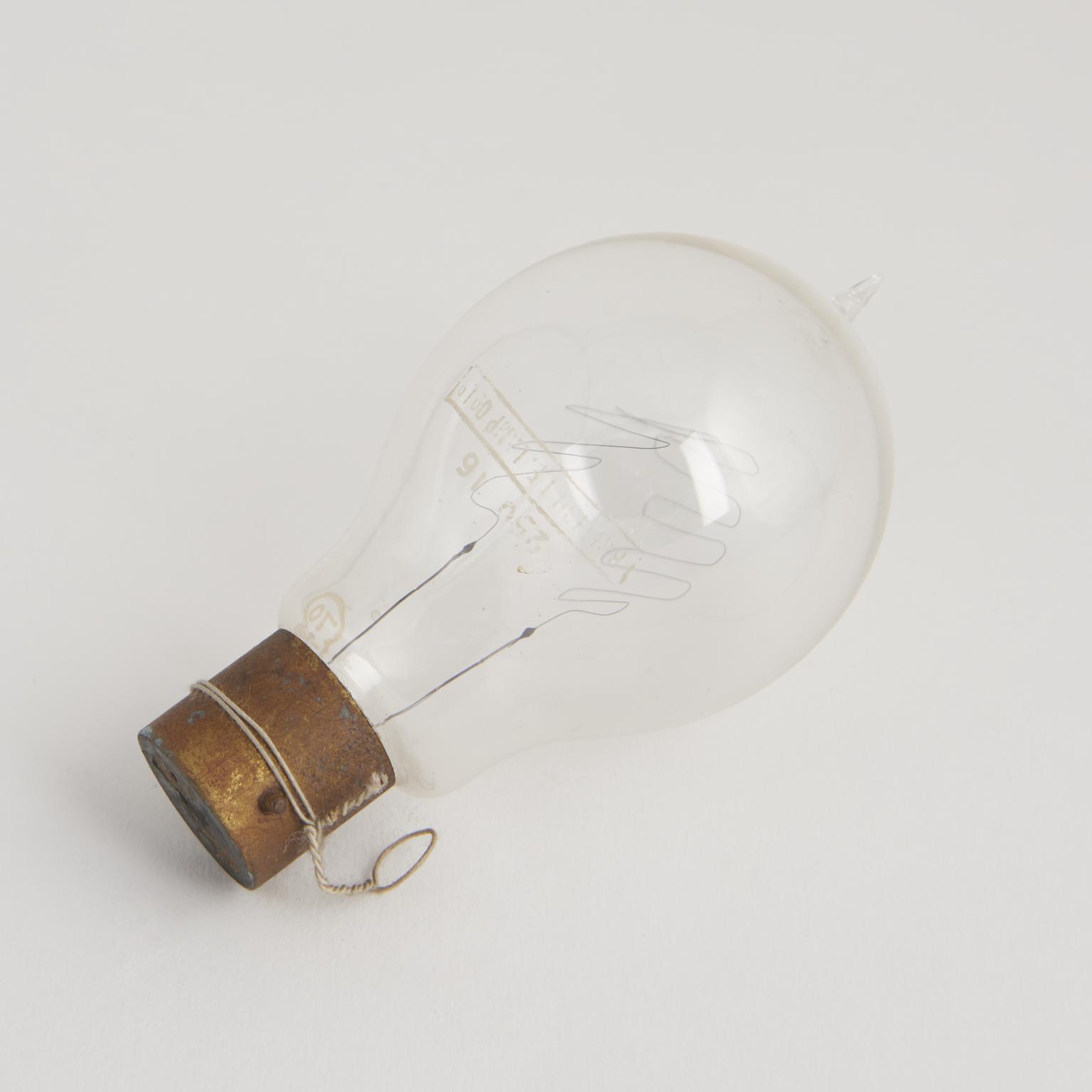
One of eighty-six early incandescent lamps: Zig zag filament

One of eighty-six early incandescent lamps. Arched filament, very stiff. No supports. Filament attached by certain 'cement' to drilled carbon cylinders inserted over the lead in wires. Twin inner stems mercury (?) silled, sealed with plaster of Paris. Clear ellipsoidial bulb, long parallel neck. Top pip. No cap- copper wires project below plaster and are bent into loops. Lane-Fox, 1880-81 According to label attachment by string (which also says, Presented by W. Kingsland Esq, and carries date in a different hand, 5th July 1915. Label giving ratings almost totally removed.

One of eighty-six early incandescent lamps. Carbon filament lamp, 1 parchmentised thread, thickened seals, wedge joint to lead-in wires, badly broken. Lead in wires in glass H patters inner stem. Clear bulb with focused on long stem, uncapped. Top pip. Swan 1881. Paper label mark 509.3 ohms
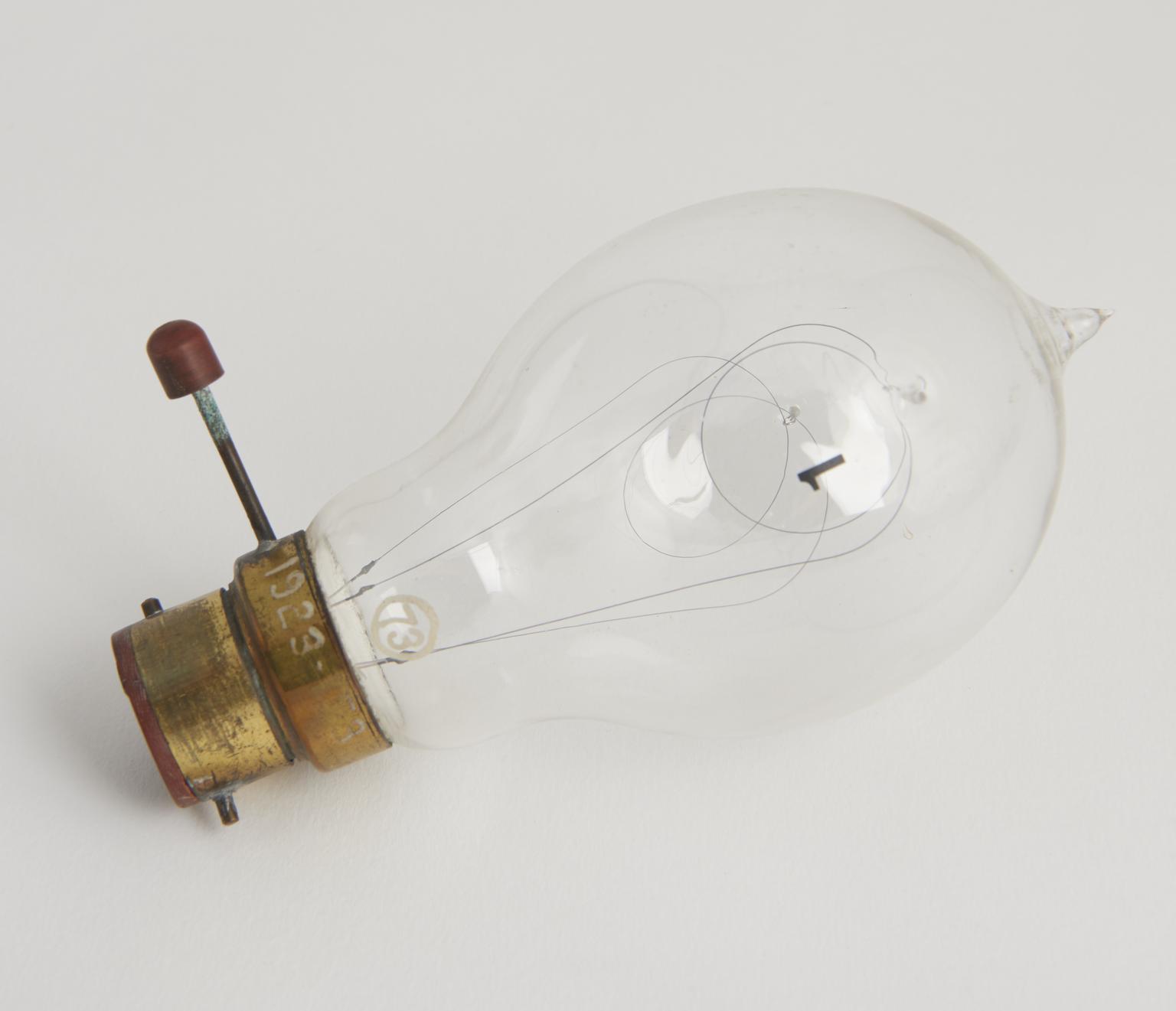
One of eighty-six early incandescent lamps. Two single loop filaments, one longer than the other. One support for each filament, attached to side of bulb. Each filament attached to platinium passing through seperate pinch seals. Pear shaped bulb, clear, with shoulder to base. Top P.P. Bayonet type cap, with shoulder, but with unusual bottom contacts, and with horizontally projecting pin and knob from base. Base attached with plaster but insulation at bottom is fibre, and there are three segmental contacts, with a gap for the rest of the circle. (? Is this a switch - use the knob to turn the lamp between off/dim/bright). Ediswan - etched (faintly) on glass. 100 - 8, 100 - 16 etched faintly on glass (volts-c.p.). Also, '32' etched on glass nearone filament support, in script.
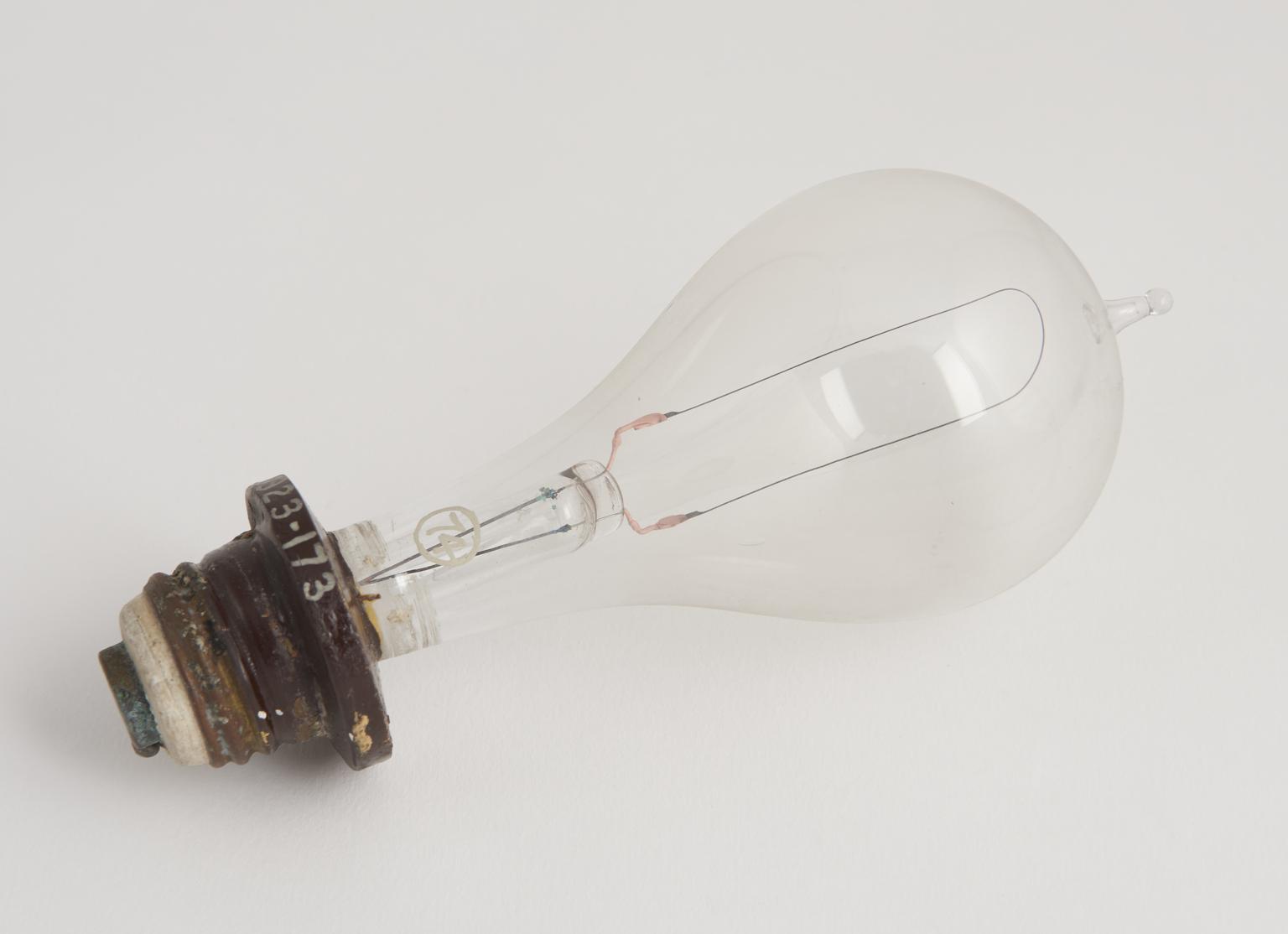
One of eighty-six early incandescent lamps. Bamboo filament, thick ends, arch shaped. Copper plated joint to copper (?) clip attached to platinium wires passing into hollow stem where they join to copper wires. No filament support. Teardrop shape clear glass bulb. Top pip. Plaster base, with flange, Edison screw contact, with metal button. Plaster painted brown. Edison - Tie on labels says made early in 1882. Rating not given: 16 c.p.? Label says "Presented by A.H. Allen Esq," 10th December 1914.
Filaments made from paper were not entirely satisfactory. Filaments made from bamboo proved to be much better and were used in all Edison lamps for a number of years.
Edison tried many different materials for his filaments. The first sample of bamboo reputedly came from a palm-leaf fan found in the laboratory. Edison sent explorers all over the world to look for the best type of bamboo, but a supply of a suitable type was easily arranged from Japan. It was probably in the spring of 1880 that Edison first tried bamboo, though in June 1880 he was still trying new materials.

One of eighty-six early incandescent lamps
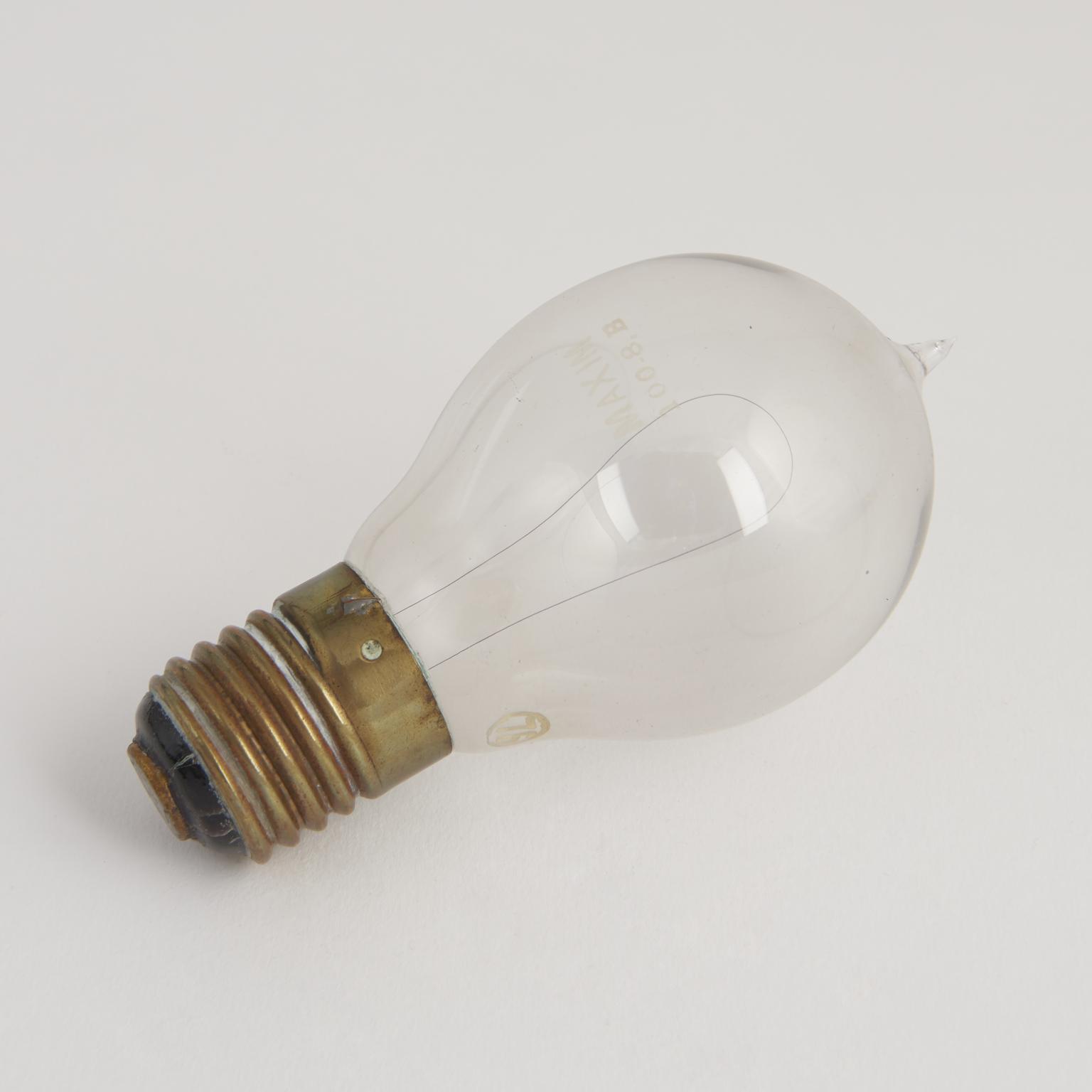
One of eighty-six early incandescent lamps. Arch filament, no support. Short platinium in pinch seal. Pear shaped bulb, plaster attached? Black insulation at base looks like a sort of glass. Maxim etched on glass. 100 - 8 B etched on glass (volts - c.p. 8?)

One of eighty-six early incandescent lamps. Probably single loop filament, probably no filament supports. Lead in wires no visible. Pear shaped, with shoulder at base. Deep red colours inside. Sealing pip at top. Bayonet cap, plaster insulated, segmented flat brass contact pads. Robertson etched on glass. 150 - 16 D.E. etched on glass (volls./c.p)

One of eighty-six early incandescent lamps: Carbon filament lamp, bayonet cap.
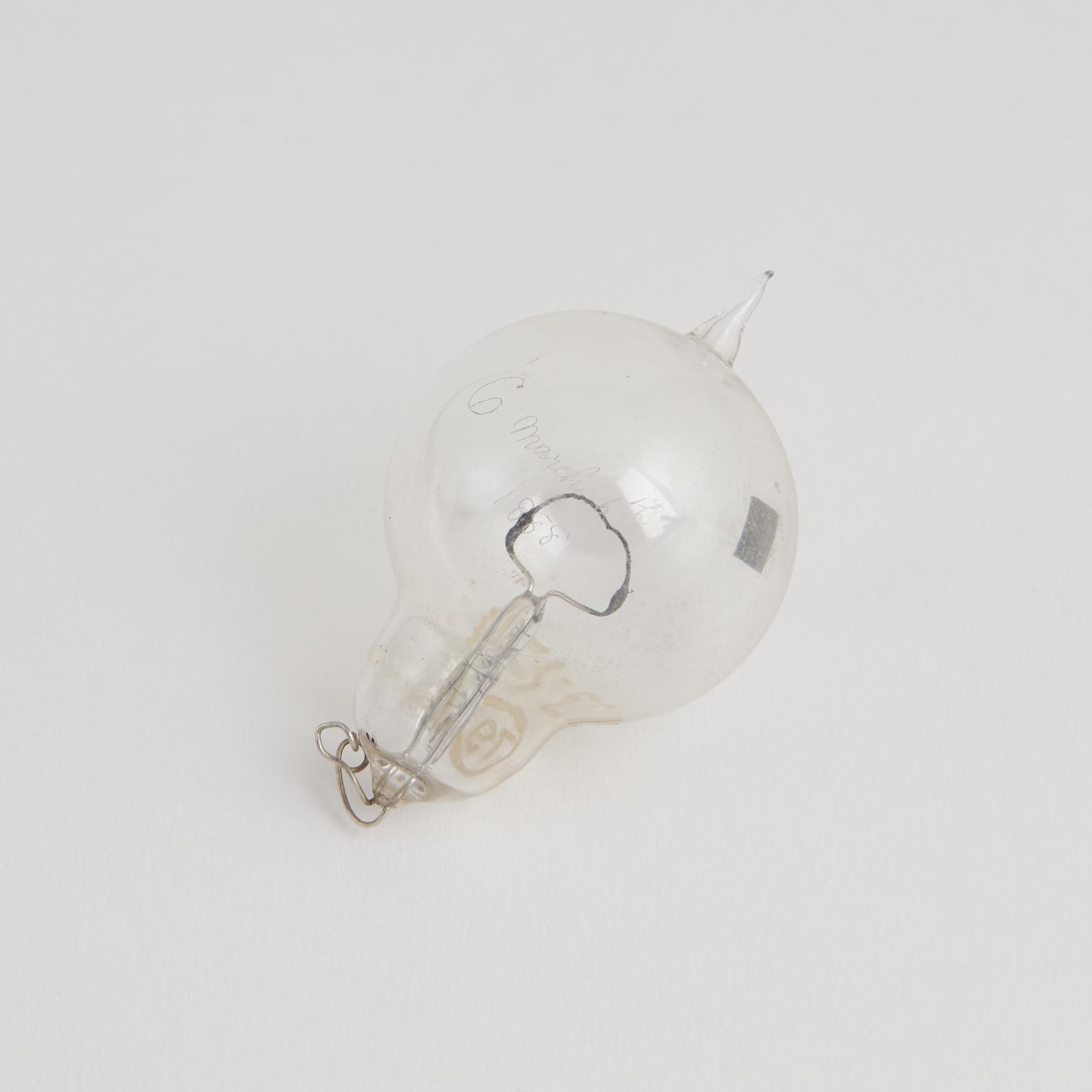
One of eighty-six early incandescent lamps. Short and filament, rather thick with curiously rough surfaces and rather bulky joints. No filament supports. Attached to platinium wires passing through long internal stem. Small spherical bulb with neck. Top pip. No base - platinium wires project about 2cm, bent back. Manufacturer unknown. Has "6 March 6th 1888" engraved in glass. No ratings. Shape suggests a san or woodhouse & Rawson lamp - but why the engraving?
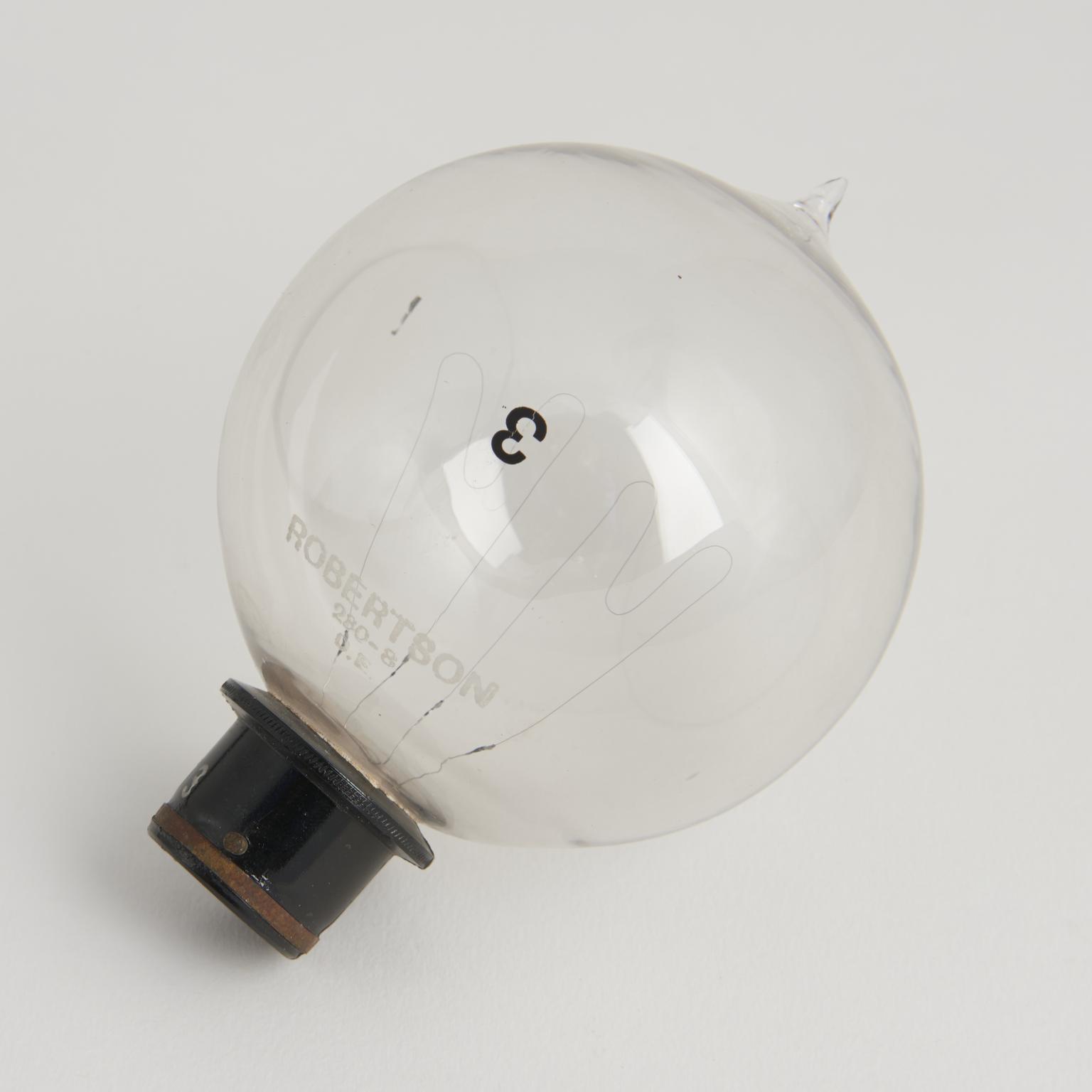
One of eighty-six early incandescent lamps. Carbon filament lamp, two M-shaped filaments, no filament supports. Four platinum lead in wires pass through same quick seal, clear spherical bulb. Top pip. Bayonet cap of insulating material encircled by brass band. Flange on cap near glass. Two elliptical brass contact plates. Robertson etched onglass. 280-8 D.E. etched on glass (volts-c.p.) There are only two electrical contacts the filaments are either inseries or parallel, probably series given the light voltage.
The Robertson Company began to manufacture lamps in 1895. J. C. Robertson had begun working on electric lamps with St. George Lane Fox and the factory used by the company had originally belonged to the Brush Company, which had once manufactured Lane Fox lamps. Like other companies, the Robertson Company made a wide range of lamps.
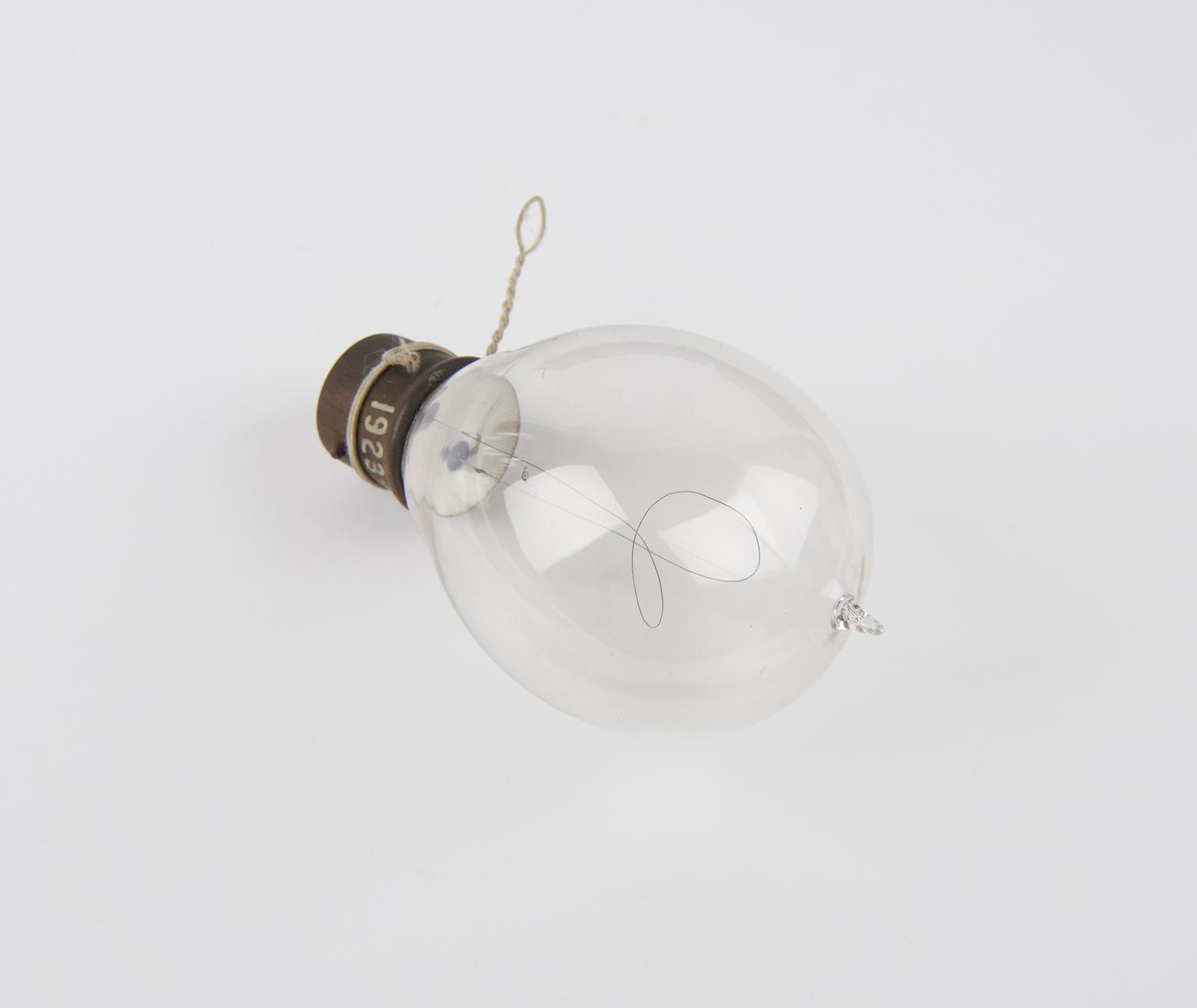
One of eighty-six early incandescent lamps. Carbon filamentlamp, single looped filament, no supports. Short lead in wires, filted through blue glass pieces, attached to bulb. Clear round bulb, without neck. Top pip.Single contact bayonet cap, with shoulder attached & insulated with plaster. Manufacturer unknown. No markings.
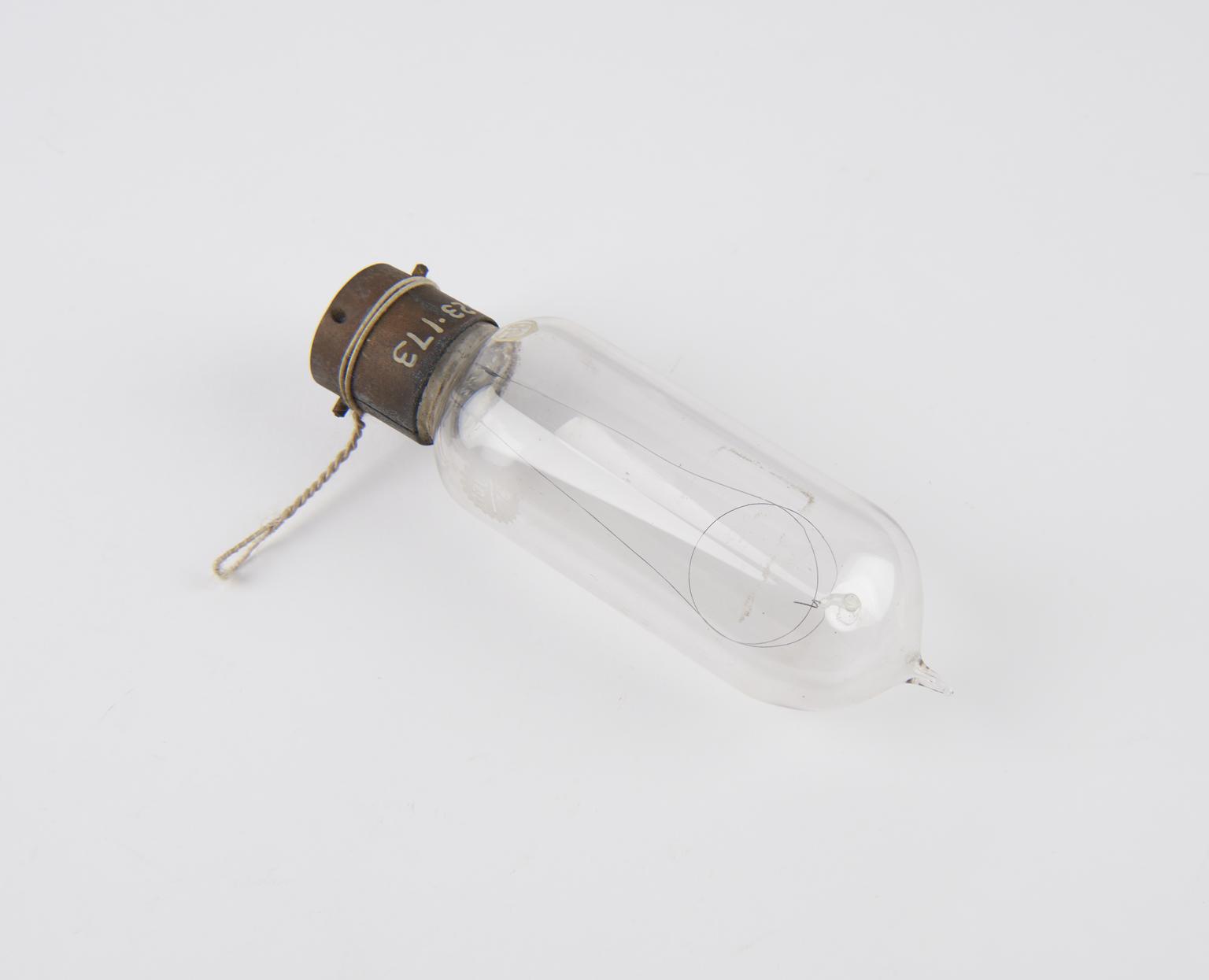
One of eighty-six early incandescent lamps. Carbonfilament lamp, single loop filament, joints to lead-in wires not clear. One filament support, near top of bulb, cylindrical bulb with shoulder at base.Top pip. Bayonet cap, now split and loose. porcelain insulated with elliptical flat brass contact plated.Manufacturer not specified. 100/16 etched on glass (votls/c.p.).

One of eighty-six early incandescent lamps. Carbon filament lamp, single loop filament, one filament support, extending vertically from base. Lead in wires, single piece platinum: quite long. Pass through glass bead which also carries the support. Long pear shaped bulb; with shoulder at base. Top pip. Bayonet cap, with pronounced shoulder. Attached by plaster-dumples in glass bulb. Insulating material is black. Elliptical brass contact packs with holes through which lead in wire soldered.Manufacturer unspecified. 8 150 marked on base (c.p. volts).
One of eighty-six early incandescent lamps. Carbon filament lamp, single loop filament, no filament support. Leain wires not visible. Bulb half-frosted externally from base half way to pip-decorative sculloped edge to frosting.Top pip.Bayonet cap appaently attached by plaster, through insulation at bottom is black. Two elliptical flat brass contact plated. Manufacturer unspecified. No ratings given.
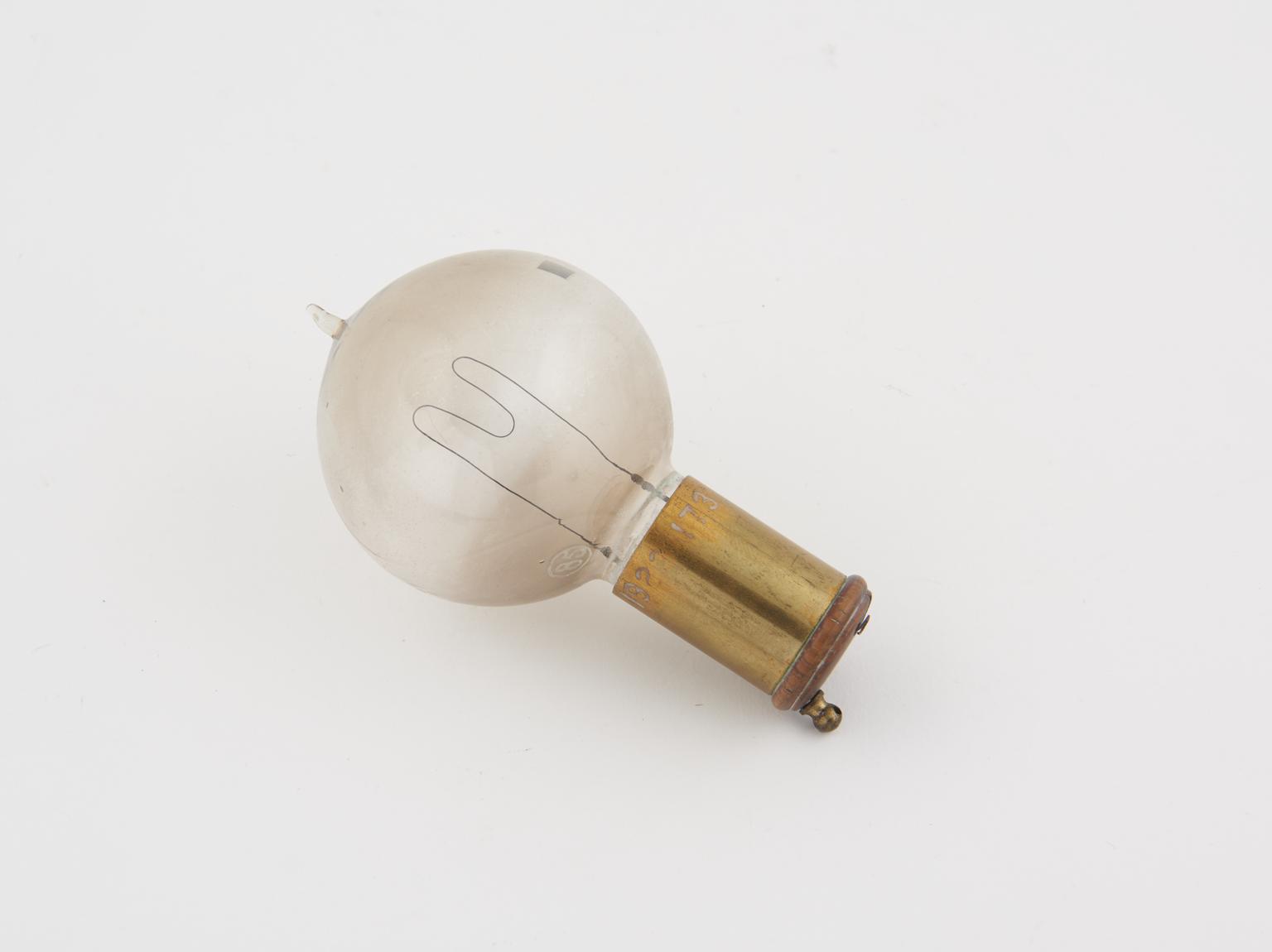
One of eighty-six early incandescent lamps. M-shaped round, thickish carbon filament. Apparently attached by (metal?) tubes to lead in waires on short stem, hidden by base. Round claw bulb, some blackening. Top pip. Attached to Cylandrical metal tube by plaster, with wooden plug on facing connecting posts and female screw thread. (Grookes??) No markings. Some similarities to 1923-173/56. Probab a Croolies lamp - similar to 1923-173/2, which is marked croolies
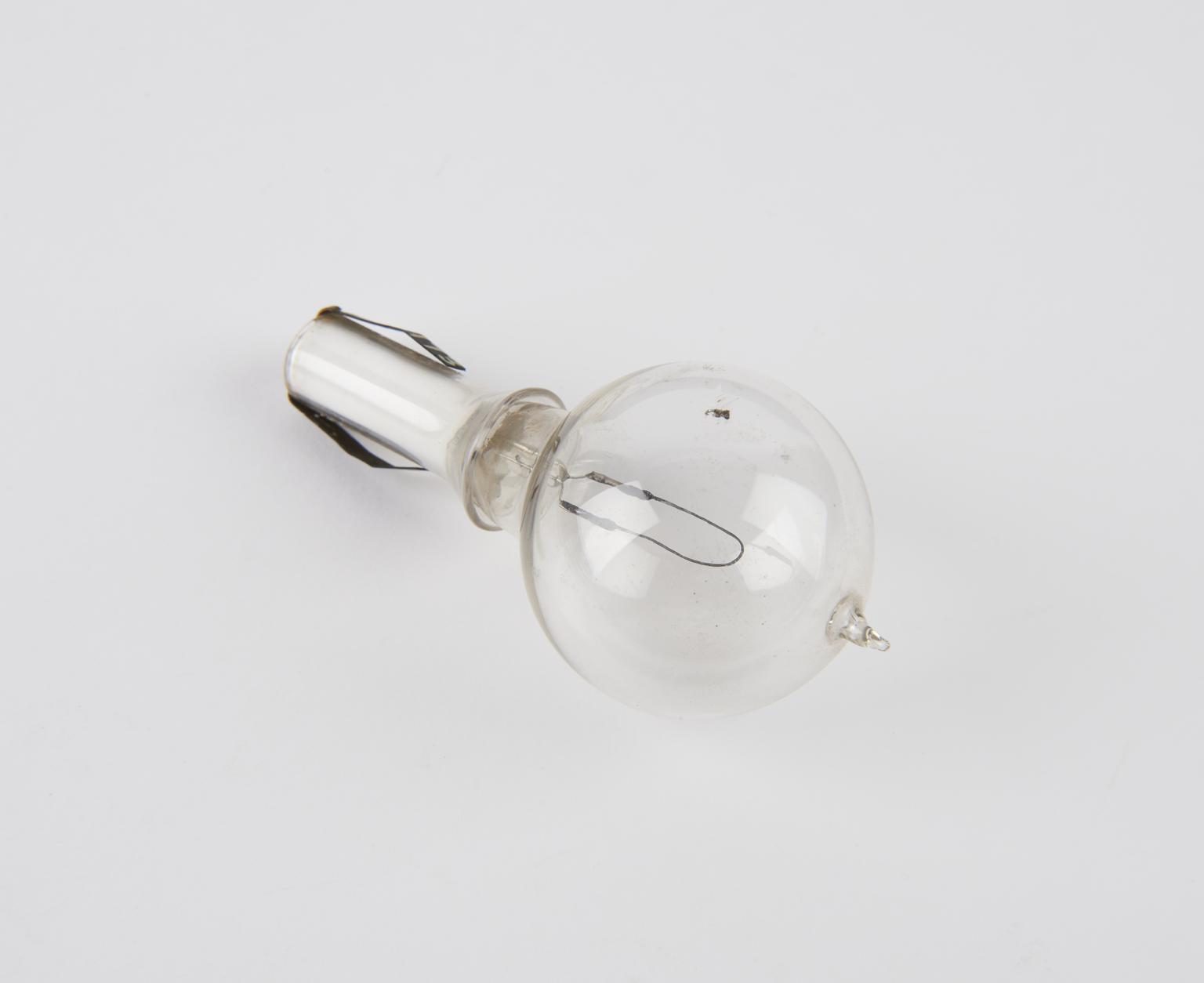
One of eighty-six early incandescent lamps. Arch filament, quiet stiff. No filament supports. Filament cemented into platinium (?) tubes crimped over leading - in wires passing through a short single stem. Round bulb, with short neck fitting into flared glass tube and attached by plaster (now loose) wires brought out to brass strips bent up side of glass tube. Top pip, no base, Manufacturer unknown, no rating given.